








By Reine Juvierre S. Alberto
THE country’s inflation print could ease to 2 percent in March, reinforcing expectations that the Bangko Sentral ng Pilipinas (BSP) will reduce key policy rates in its April 10 meeting, according to ANZ Research.



By Ada Pelonia @adapelonia
BRAZIL is keen on expanding the basket of agricultural goods it exports to the Philippines, particularly plant-based products.
Luis Rua, secretary of trade and international relations of Brazil’s ministry of agriculture and livestock, said he met with his local counterpart to discuss potential access to the Philippine market for apples, peanuts, and onions.
“We’re here to show that we can also be a good partner apart from meat, which is our [top] export to
the Philippines,” Rua told reporters on the sidelines of a recent food expo in Pasay City.
“We want to expand the range of products that we can offer to the Philippines,” he added. Currently, Rua said both governments are in discussion over a technical agreement that will iron out sanitary issues and market access for onion shipments into the Philippines. He hinted at the possibility that the technical agreement may be finalized this year.
“That’s our idea—to very quickly solve all the technical issues, and then we can export more products
By Bless Aubrey Ogerio
THE Philippine economy is expected to grow by 5.9 percent in 2025, driven mainly by strong domestic consumption, according to Citi.
Amol Gupte, Citi’s head for South Asia, said last Friday that inflation is expected to remain “manageable” at 2.6 percent, which could spur consumption.
“Our belief is that the Philippines this year will get very close to 6 percent, 5.9 percent to 6 percent,” Gupte said during a media briefing in Makati City.
“Inflation, we think, will remain
well controlled at about 2.6 percent. It’s come much below many people’s expectations, which is a good thing.”
Economic managers have been targeting to grow GDP by 6 percent to 8 percent this year. For growth to hit 7 percent or higher, Gupte said the Philippines would have to hasten its industrial development.
Recent data from the Philippine Statistics Authority showed a 0.8 percent year-onyear growth in the Producer Price Index (PPI) for manufac
turing, up from 0.1 percent in

December. This marks a reversal from the 1.1 percent annual decline recorded in January 2024.
As for the risk posed by the trade war on the country’s economy, Gupte said the plan of the United States to slap reciprocal tariffs on all its trade partners will have minimal impact on the Philippines.
Under this plan, Washington will match tariffs applied by other countries on American exports.
“The denominator is not very big compared to the rest of your economy,” he said. “Could it have an impact? Yes, but I don’t think it will be material given the size of your GDP and the domestic consumption-driven nature of the economy.”
To prepare for this, he urged the government to consider adjusting certain import taxes to minimize any negative effects, especially in sectors other than agriculture.
Political risks ON the political front, Citi Philippines CEO Paul Favila played down concerns over the impeachment proceedings against Vice President Sara Duterte.
“Politics is a constant. We will have to deal with politics anywhere in the world,” Favila said. “It’s part of the political process, and that in itself is a reinforcement that democratic institutions in this country are working.”
Favila added that the government’s implementation of programs remains on track, and the political landscape is unlikely to deter investor confidence.
By Reine Juvierre S. Alberto @reine_alberto
THEnational government’s debt payments dropped to P106.510 billion in January 2025, as amortization—the repayment of principal debt—declined significantly.
Latest data from the Bureau of the Treasury (BTr) showed the government settled P106.510 billion of its obligations in January 2025. This is lower by 32.96 percent than the P158.898 billion recorded during the same month in 2024.
The decrease in the debt payments was due to seasonal factors, as the month recorded a budget surplus after a wide deficit in December 2024, according to Michael L. Ricafort, chief economist at Rizal Commercial Banking Corporation.
Broken down, 98.05 percent of the government’s debt payments for the month accounted for interest payments while the rest were spent on amortization.
Interest payments rose to P106.510
billion in January 2025, 40.70 percent higher than the P74.221 billion recorded in January 2024.
Ricafort said the sharp increase in interest payments might be due to relatively higher interest rates since 2022 and the foreign exchange rate in January which increased the peso equivalent of external debt interest payments.
“Also, the fact that the large borrowings, especially at the height of the Covid pandemic, the interest payments of which are already being serviced,” he added.
Domestic sources were paid P72.286 billion in interest in January 2025, up by 48.05 percent from the P48.823 billion settled a year ago.
This includes interest payments
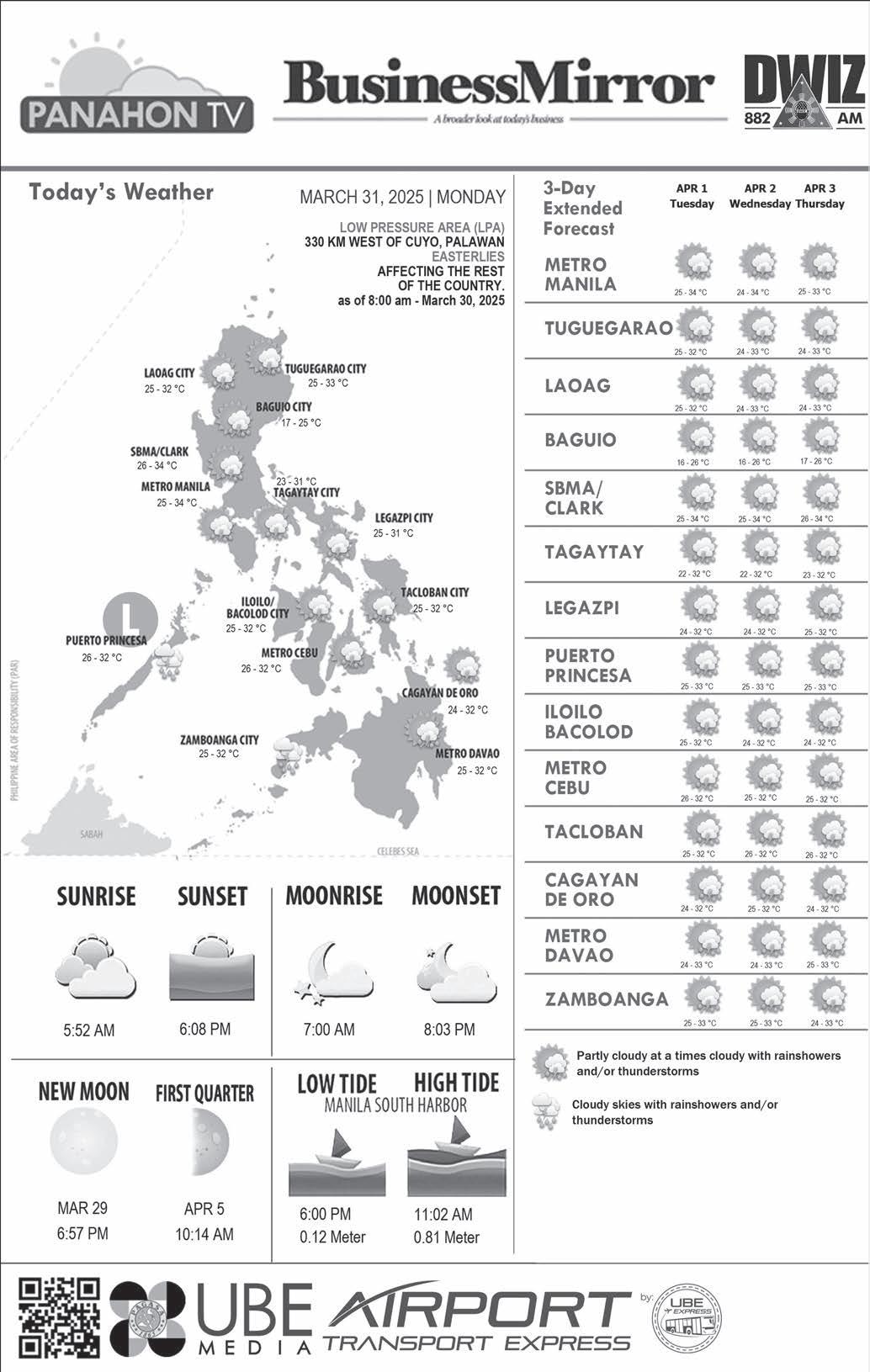
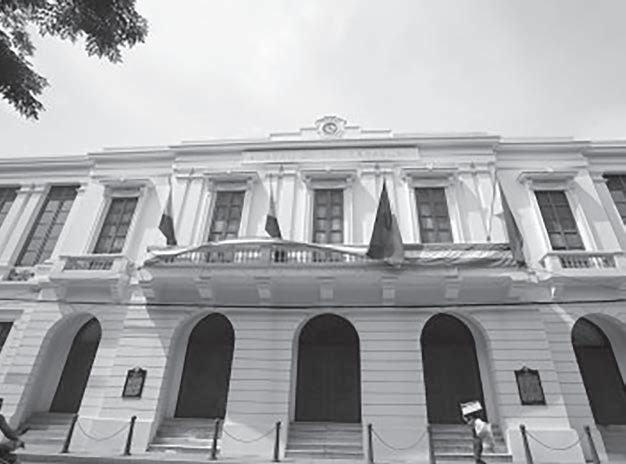
amounting to P3.235 billion for Treasury bills, P63.673 billion for fixed-rate Treasury bonds, P3.575 billion for retail Treasury bonds and P1.803 billion for other obligations.
About P32.149 billion in interest payments were also disbursed to external financiers, higher by 26.58 percent from last year’s P25.398 billion.
Meanwhile, amortization shrank by 97.54 percent to P2.075 billion in January 2025 from P84.677 billion in January 2024.
Ricafort said the bulk of principal payments may have been concentrated before the end of 2024, which led to a slowdown in amortization.
The decline may also be due to lower debt maturities in January, consistent with the budget surplus for the month, he added.
As such, amortization shelled out to external sources sank by 97.92 percent to P1.758 billion from P84.539 billion in January 2024. However, principal payments to foreign financiers climbed by 129.71 percent to P317 million from the previous year’s P138 million.
Last year, the government settled a record P2.020 trillion in liabilities, as debt servicing increased by 26 percent from P1.603 trillion in 2023.
The government’s outstanding debt posted a new record high of P16.312 trillion as of end-January 2025, 10.29 percent higher than the P14.790 trillion recorded during the same period a year ago. By end-2025, the government’s debt service bill is seen to reach P2.050 trillion.
Continued from A14
monsoon or “amihan,” signaling the onset of warmer conditions across the country.
WESM operator Independent Electricity Market Operator of the Philippines (IEMOP) has initially assessed that there will be no expected yellow or red alerts from March 27 to 31. However, the shutdown of gas plants from March 29 to 31 may temporarily push spot market prices upward.
The DOE announced last week that South Premiere Power Corporation (SPPC) and Excellent Energy Resources Inc. (EERI), the natural gas power generation facilities jointly owned by Meralco PowerGen, San Miguel Global Power, and Aboitiz Power, will implement a scheduled shutdown from 9:00 a.m. of March 29 until 6:30 am. of March 31. This temporary shutdown is necessary to facilitate mechani-
cal activities at Linseed Field Corporation’s liquefied natural gas (LNG) terminal, a crucial step towards completing its first onshore LNG storage tank by the end of April this year.
The LNG terminal is expected to resume sending out gas, enabling EERI to synchronize to the grid by 8:30 p.m. on Sunday, while SPPC Block 1, which requires a longer start-up period, is expected to synchronize by 9:00 p.m. on the same day. Both EERI and SPPC will have a full capacity of 1,350 megawatts (MW) from the current 1,300 MW by 6:30 AM on Monday. The shutdown of these plants has been strategically planned in coordination with the National Grid Corporation of the Philippines to coincide with lower system demand, minimizing potential supply disruptions.
Continued from A14
reciprocal tariffs will be much broader than simply matching other countries’ tariffs currently imposed on the US,” Japan-based think tank Nomura Economic Insights said in a commentary sent via e-mail.
With this, Nomura said US reciprocal tariffs will be “indeed more difficult to quantify.”
“The investigations by the United States Trade Representative, the Secretary of Commerce and Treasury Department that are due to be completed by April 1 cover many other areas, including but not limited to: the size of US trade deficits with other coutnries, de minimis exports, VAT rates, digital taxes, circumvention of US tariffs through third
government’s inflation target of 2 percent to 4 percent this year. The sharp drop in rice prices in February due to lower international quotations is expected to further ease the food staple’s inflation rate. However, electricity prices were slightly elevated this month while petrol prices were lower compared to February, Goh said.
Bangko Sentral ng Pilipinas (BSP) Governor Eli M. Remolona Jr. said rice is no longer a risk to inflation since prices have gone down, but inflationary pressures could come from electricity and transportation costs. The BSP, however, expects inflation to accelerate and breach the government’s target this year due to expensive oil imports and the depreciation of the peso. (See: https://businessmirror.com.ph/2025/03/17/inflation-may-quicken-on-costlydubai-crude/).
As such, the BSP revised upward its baseline inflation forecast for 2025 to 3.5 percent from 3.3 percent—still within the target range. Inflation is estimated to reach 4.1 percent in 2025 if Dubai crude oil prices would hit $100 per barrel. If a barrel would cost $85 in 2026, then inflation could settle at 4.2 percent. ANZ Research expects overall inflation to settle at 3.4 percent in 2025 and 3.5 percent in 2026, still within the government’s target range.
The Philippine Statistics Authority (PSA) is set to release the country’s inflation data for March on April 4. ANZ Research expects the key policy rate to be reduced by 25 basis points (bps) to 5.50 percent. Another 25-bps rate cut could be delivered by the end of the year.
Local monetary officials have signaled the possibility of a rate cut on April 10, with Remolona, who serves as chairman of the Monetary Board, saying there is “a good chance” of a 25-bps cut.
Finance Secretary Ralph G. Recto, who is also a member of the Monetary Board, said key policy rates could be slashed by up to 75 bps this year on the back of easing inflation. In its previous meeting, the Monetary Board maintained key policy rates at 5.75 percent due to global uncertainties.
countries, currency manipulation, state subsidies and various other non-tariff trade barriers,” it added.
The Japan-based think tank also said that tariffs could even be imposed for “geopolitical means.”
Nomura shared these insights ahead of Washington’s announcement on reciprocal tariffs on April 2.
“Of course, we are missing many possible criteria, and there could be exclusions, and this says nothing of the magnitude of the tariffs. All this is another way to say there is massive uncertainty on the targets, size and scope of the tariffs expected on April 2. Good luck navigating the fog of tariffs,” it added.
to the Philippines,” he said. Rua said Manila and Brasilia are exploring the possibility of trading genetic materials for dairy cattle and poultry.
Brazil was the country’s top supplier of meat products, particularly pork, chicken, and beef, in 2024, based on Bureau of Animal Industry (BAI) data. The South American nation accounted for nearly 37 percent or 536,340 metric tons (MT) of the country’s total meat shipments at 1.45 million metric tons (MMT).
For this year, Rua said Brazil wants to ship new meat products to the Philippines, such as bone-in cuts and beef offals.
“We hope these discussions with the Filipino government to will add new products,” he said.
Meanwhile, Rua said government officials are also discussing the possibility of opening up Brazil’s market for Philippine fish products like tuna and sardines.
“The Philippines wants to export some seafood and fish products to Brazil,” he said. “We are going to discuss technically how to proceed in order to have Filipino seafood and fish products in Brazil.”
Rua said the agricultural trade relationship between the Philippines and Brazil would be further enhanced through the expansion of farm goods being exported by both countries.
“We hope we can move forward on this very good relationship that we have with [the Philippine] government. We believe this relationship will be even stronger in the near future,” he said.
By Jovee Marie N. dela Cruz

A@joveemarie
LEADER of the House of Representatives on Sun -
day revealed a new set of fictitious names, dubbed “Team Grocery,” linked to the alleged misuse by Vice President Sara Duterte of her P500 million confidential funds at the Office of the Vice President (OVP).
The names—Pampano, Harina, Casim, Bacon, and Patty Ting— were disclosed by House Deputy Majority Leader Paolo Ortega following previous controversies involving other alleged fake names
like “chichirya,” “cellphone,” “fruit,” the “Dodong Gang,” and “Team Amoy Asim.” Ortega, who represents La Union, noted the “uncanny resemblance” of the new names to common grocery items.
Topping the list is “Beverly Claire Pampano,” referencing a popular fish sold nationwide, Ortega said.
Next, according to Ortega, is “Mico Harina,” whose surname translates to “flour,” a basic ingredient in bread and native pastries.
Then there’s “Patty Ting” and “Ralph Josh Bacon,” which evoke burger staples, while “Sala Casim” refers to “kasim,” a pork shoulder
cut widely used in Filipino dishes like adobo and menudo, Ortega added.
“The new names we’ve seen look like a shopping list for the market or grocery,” Ortega said.
Ortega said the names of Pampano, Harina, Patty Ting, Bacon, and Casim were submitted by the OVP to the Commission on Audit (COA).
Like many others flagged by the House of Representatives, Ortega said Pampano, Harina, Patty Ting, Bacon, and Casim do not match any official birth, marriage, or death records from the Philippine Statistics Authority (PSA).
The lawmaker argued the “whimsical nature” of the names and the lack of government records suggest a deliberate attempt to create a “grocery list” to facilitate the release of confidential funds.
Similar irregularities have surfaced in records related to the OVP and the Department of Education’s (DepEd) combined P612.5 million confidential funds, including names like “Amoy Liu,” “Fernan Amuy,” “Joug De Asim,” “Mary Grace Piattos,” and “Kokoy Villamin.”
Ortega reported that out of 1,992 supposed recipients of OVP confidential funds, a significant majority lacked birth, marriage, or death records.
Manila Rep. Joel Chua, chairman of the House Committee on Good Government and Public Accountability, also revealed that 405 out of 677 names listed as DepEd beneficiaries had no birth records.
ASIGNIFICATE decline in the incidence of major crimes is being overshadowed by a surge of online misinformation that distorts public perception and fuels unnecessary fear, a leader of the House
of Representatives said.
Citing official figures from the National Police chief, Gen. Rommel Francisco Marbil, Assistant Majority Leader Jil Bongalon cited a 26.76 percent drop in focus crimes—from 4,817 cases
between January 1 and February 14, 2024, to 3,528 in the same period this year.
“Let’s be clear: crime is going down. The data is there,” Bongalon said in a statement on Sunday.
However, Bongalon warned that these improvements are being undermined by viral social media content—often lacking context or entirely false—that continues
See “Crime,” A4
By Justine Xyrah Garcia
HE Commission on Elections (Come -
Tlec) has refuted claims that the signatures collected during the delivery of voter information sheets (VIS) will be used for political purposes.
Comelec Chairman George Erwin M. Garcia clarified that the required signatures are solely for accounting purposes and will not be used for a people’s initiative or impeachment efforts.
“When you receive your VIS, our personnel will ask for your signature. This is necessary because the distribution personnel’s salary is based on the number of VIS they distribute in a barangay or precinct,” Garcia explained in Filipino.
His statement comes after reports surfaced that some voters in the Caraga region refused to accept their VIS owing to allegations that their signatures would be used to support a people’s initiative for Charter change or the impeachment of Vice President Sara Duterte.
To address these concerns, Garcia emphasized that only Comelec personnel—wearing official Comelec IDs—will distribute the VIS, with no involvement from barangay officials to prevent political interference.
He also urged voters to accept the VIS, highlighting its importance in keeping them informed about the May 12 elections.
Registered voters will each receive a four-page VIS containing their name and address, polling place and precinct number, voting instructions and reminders, as well as the list of candidates for national and local positions, including party-list groups. All VIS will be printed in Filipino to make them accessible to the majority of voters.
Enhanced voting experience BEYOND VIS distribution, Comelec is taking additional steps to improve voter accessibility and information.
Two weeks before

By Bless Aubrey Ogerio
WITH the summer sun bearing down, many Filipinos would rather beat the heat at home than spend their summer days swimming, a recent survey by a public opinion firm showed.
WR Numero’s February 2025 poll revealed that while 44 percent of respondents are excited to go swimming, a significant 33 percent prefer to stay indoors to watch movies, listen to music or read books.
Other preferred activities include learning a new skill (13 percent), hiking (12 percent), visiting public places for leisure or entertainment (10 percent) and traveling locally (8 percent). Only 3 percent expressed interest in international travel.
The preference for staying home was most pronounced among senior citizens, with 45 percent of
Filipinos aged 60 and above opting to remain indoors.
Meanwhile, younger Filipinos under 30 are more likely to go swimming, with nearly half (48 percent) looking forward to the activity.
Economic differences also played a role in summer plans. While 59 percent of middle-income and upper-income respondents prefer swimming, 36 percent of those in poorer households chose to stay home, the highest among income groups.
Regionally, Metro Manila saw 34 percent of its residents choosing to stay home, compared to 38
percent in Visayas.
Respondents in Luzon outside the capital showed a stronger preference for swimming, while in Mindanao, preferences were evenly split, with 33 percent favoring both swimming and staying home.
Heat index
IN a media forum last week, the Philippine Atmospheric, Geophysical and Astronomical Services Administration (Pagasa) climate monitoring and prediction section chief Analiza Solis warned that the heat index in some areas could reach up to 52°C in the coming weeks, particularly in coastal and valley regions.
The weather bureau, on the occasion, announced the end of the Amihan (Northeast Monsoon) season in most parts of the country. Solis said that while the current highest recorded heat index this year has been around 46°C to 47°C in parts of Tarlac and Pangasinan, the hottest temperatures are typically observed in late April to May.
“Hopefully, we won’t reach 52°C, but there is still a possibility,” she said, recalling that last year’s peak heat index coincided with a strong El Niño episode.
By Jovee Marie N. dela Cruz @joveemarie

ALEGISLATOR is pushing for the institutionaliza -
tion of a pension system for overseas Filipino workers (OFWs).
ACT-CIS Rep. Erwin Tulfo said he will file a measure seeking to institutionalize a pension system for OFWs, allowing them to enjoy benefits upon their retirement from working abroad.
“OFWs are called ‘modern-day
heroes’ because of their noble contribution to the country’s economy at the expense of being away from their families,” he said.
“But by the time they get older and can no longer work, they become reliant on their children. Is this how we treat our heroes?” added Tulfo.
He argued that a dedicated pension system is a just way to reciprocate the OFWs’ contributions.
“It’s the country’s way of saying thank you to our OFWs for
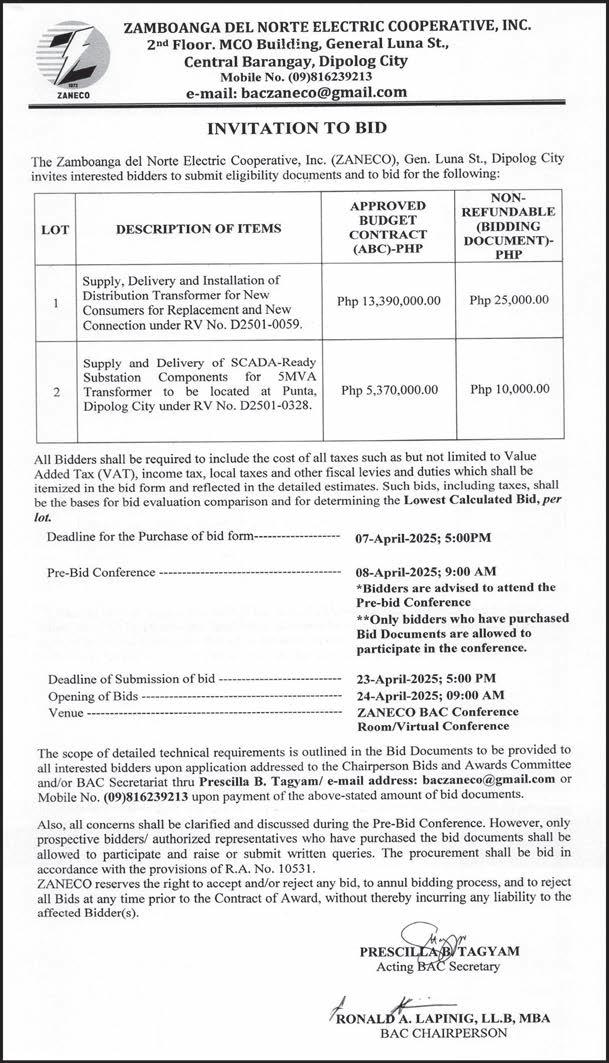
She identified areas near bodies of water and those within valleys as most prone to experiencing extreme heat and humidity. Coastal regions like Dagupan and Zambales, as well as valleys in Tuguegarao City and Aparri in Cagayan province, are expected to record higher heat indices.
Pagasa advised the public to take precautionary measures to prevent heat-related ailments, particularly during midday hours when temperatures are at their peak. It also reminded citizens to stay hydrated, avoid prolonged sun exposure and monitor weather updates.
“Department of Science and Technology-Pagasa will continue to closely monitor the country’s weather and climatic conditions and their potential impacts, while the public and other concerned agencies are encouraged to regularly check for updates,” the agency added.
The WR Numero survey was conducted from February 10 to 18 this year, through face-to-face interviews with a sample of 1,814 Filipinos aged 18 and older. It has a margin of error of ±2 percent at a 95 percent confidence level.
themselves,” he said.
He specifically cited domestic helpers, laborers, and drivers who receive meager wages and live paycheck to paycheck, lacking the financial capacity to save.
being strong pillars of the nation for many years while working abroad. It is only right and just to return the favor,” added Tulfo as he stressed the financial challenges faced by many OFWs, who often prioritize family needs over personal savings.
“A lot of our OFWs cannot save up because they prioritize paying for their children’s school fees or building a decent home for their family. The needs of the people who rely on them come first, leaving them with nothing for
Continued from A3
to alarm and mislead the public.
Focus crimes include theft, robbery, rape, murder, homicide, physical injury, and carnapping of motorcycles and motor vehicles. Among these, rape recorded the sharpest decline, declining by more than 50 percent.
Year-on-year data further reflects a 7.31 percent decrease in focus crimes, from 41,717 cases in 2023 to 38,667 in 2024.
Bongalon’s remarks align with the earlier call of Marbil, who urged media practitioners and online users to report crime with fairness and context, avoiding the amplification of isolated incidents that distort the broader picture.
Marbil attributed the sustained drop in criminality to heightened police visibility, advanced investigative tools, digital
The proposed measure will establish a pension fund with contributions from both OFWs and the government. Tulfo suggested that the government could contribute double or triple the OFW’s contribution.
Tulfo clarified that the proposed OFW pension system will be separate from the benefits OFWs receive from the Social Security System (SSS) upon reaching 60 years old, creating a new, OFWspecific retirement plan.
surveillance, and stronger community cooperation—efforts that align with President Marcos’ vision of a safer, more secure Philippines.
Still, Marbil acknowledged that crimes gaining traction on social media can create the false impression that criminality is worsening. He urged the public to use these platforms responsibly—as tools for safety, not fear—and to report suspicious activities rather than spread unverified content.
Bongalon, the nominee of the party-list group Ako Bicol, echoed that sentiment, stressing that misinformation erodes public trust and affects the morale of law enforcement officers.
“Fake news is a crime in itself—it steals peace of mind and sows unnecessary fear,” the House leader said.
Bongalon called for stronger media literacy, especially among the youth, to help Filipinos discern credible information from viral disinformation.

By Justine Xyrah Garcia
THE Department of Labor and Employment (Dole) has released guidelines on the proper payment of wages for employees working on the regular and special non-working holidays of April.
In a text message to the BusinessMirror, Labor Secretary Bienvenido E. Laguesma emphasized that the advisory serves as a reminder to ensure workers receive the correct wages, helping to prevent disputes in the workplace.
“The Labor Advisory was issued as a gentle reminder so that correct payment to workers is ensured, thereby avoiding potential conflict or misunderstanding in the workplace,” Laguesma said on Sunday. He added that the issuance aligns with the Presidential Proclamation on Holidays, which mandates Dole to provide guidelines for stakeholders.
“Employers are expected to pay what is legally due to workers during the holidays, whether worked or unworked. If there’s a company policy or [collective bargaining agreement] providing for higher amounts, this should prevail and be complied with,” he said.
Employees who do not work on these days are still entitled to receive 100 percent of their daily wage, provided they report to work or are on paid leave on the day immediately preceding the holiday.
For those who will work, employers must pay 200 percent of their basic wage for the first eight hours.
Any work beyond eight hours must be compensated with an additional 30 percent of the hourly rate. If the holiday falls on an employee’s rest day, the pay increases to 230 percent of the basic wage for the first eight hours, with overtime paid at an additional 30 percent of the hourly rate.
Meanwhile, April 19 (Black Saturday) is classified as a special non-working day.
Employees who do not work on this day will follow a “no work, no pay” policy unless company policy or a CBA states otherwise. Those who work will receive an additional 30 percent of their basic wage for the first eight hours, with overtime paid at 30 percent of the hourly rate. If the special non-working day falls on an employee’s rest day, the pay increases to 150 percent of the basic wage for the first eight hours, with overtime paid at an additional 30 percent of the hourly rate.
In Labor Advisory 04 Series of 2025, Dole clarified that April 1 (Eid’l Fitr), April 9 (Araw ng Kagitingan), April 17 (Maundy Thursday), and April 18 (Good Friday) are regular holidays.
Lopez group pledges support for DENR’s ‘Forests for Life’
FIRST Philippine Holdings Corporation (FPH), one of the country’s oldest and most diversified conglomerates, has joined a newly launched Department of Environment and Natural Resources (DENR) program, calling for reforesting critical areas of the country as part of their shared commitment to climate resilience, sustainable forest management and a regenerative future.
FPH Chairman and Chief Executive Officer
Federico R. Lopez signed with Environment Secretary Maria Antonia Yulo Loyzaga a recent memorandum of understanding (MOU), wherein FPH committed participation as a partner in implementing the DENR program called “Forests for Life.”
The DENR program, which also received the support of other conglomerates, aims to plant in the next three years 10 million trees that will contribute to the capture or sequestration by the year 2038 of an estimated 6.5 million tons of carbon dioxide, one of the greenhouse gases behind adverse climate change.
“We are at this critical juncture in the history of our planet, where we urgently need to solve the climate crisis by both transitioning to a clean energy future and ultimately reducing our carbon emissions. Our support for the DENR goes beyond simply planting trees and sequestering carbon from the atmosphere. We also focus on understanding our natural ecosystems and protecting our precious but severely threatened biodiversity,” Lopez said during the MOU signing ceremony. Pilot sites for the private-public reforestation initiative are spread across critical or flood-prone areas and watersheds in Ilocos Norte, Rizal, Leyte, Bataan, Bukidnon, and Lanao del Norte. Priority tree species for planting include tropical hardwoods, such as those known locally as yakal-saplungan and palosapis, as well as dao, lamio, kalumpit, bagras, kalantas, agoho, Antipolo, bagalunga, banlag, bitaog, bogo, kupang, and talisaigubat.
FPH and its subsidiaries, led by First Gen Corporation and Energy Development Corporation (EDC), have gained extensive reforestation experience from Project Binhi, an internationally recognized reforestation program initiated by EDC to protect, conserve and propagate indigenous tree species.
Acknowledged as the Philippines’ largest reforestation project by a private company, Binhi has restored at least 10,140 hectares of denuded forest lands by planting close to seven million native trees in these areas, which now serve as biodiversity habitats for more than 500 unique fauna species. Started in 2008, Binhi has expanded its scope with the help of the University of the Philippines Institute of Biology to include the rescue from extinction of 145 species of endemic Philippine trees.
FPH with other members of the Lopez Group of Companies has developed a long-term partnership with the DENR in the conglomerate’s mission of forging collaborative pathways for a decarbonized and regenerative future.
One ongoing agreement between the DENR and First Gen along with non-profit sister company ABS-CBN Foundation calls for the protection of the marine ecosystem within the Verde Island Passage (VIP) in the provinces of Batangas, Marinduque, Romblon, and Oriental and Occidental Mindoro. This agreement strengthens efforts to save the fragile marine ecosystem in the VIP, which First Gen has been helping to conserve since the company started a VIP conservation effort, called Project Center of Center, more than 20 years ago.
FPH, is also a partner of the DENR in Project Transform (Transdisciplinary Approach for Resilient and Sustainable Communities). With support from First Gen, this flagship multi-stakeholder engagement program of the DENR aims to reshape the landscape of environmental management and climate and disaster resilience in the Philippines.

By Grant Peck & Jintamas Saksornchai
The Associated Press
BANGKOK—A unilateral partial ceasefire to facilitate earthquake relief efforts was announced on Saturday by Myanmar’s shadow National Unity Government, which coordinates the popular struggle against the ruling military. The country’s death toll from the disaster soared to 1,644. The figure was a sharp rise compared to the 1,002 announced just hours earlier, highlighting the difficulty of confirming casualties over a widespread region and the likelihood that the numbers will continue to grow from Friday’s 7.7 magnitude quake. The number of injured increased to 3,408, while the missing figure rose to 139.
The number of dead also rises in Thailand IN neighboring Thailand, the death toll rose to 17. The quake rocked the greater Bangkok area, home to around 17 million people, and other parts of the country. Many places in the north reported damage, but the only casualties were reported in Bangkok.
Of the death toll, 10 were killed in the high rise building near famous Chatuchak market that collapsed, while the rest were killed in seven other sites. Authorities in Bangkok said 83 people were unaccounted for.
On Saturday, more heavy equipment
was brought in to move the tons of rubble, but hope was fading among friends and relatives.
“I was praying that that they had survived, but when I got here and saw the ruin—where could they be? said 45-year-old Naruemol Thonglek, sobbing as she awaited news about her partner, who is from Myanmar, and five friends who worked at the site.
Aid efforts in Myanmar hindered by damage to airports IN Myanmar, rescue efforts so far are focused on the major stricken cities of Mandalay, the country’s No. 2 city, and Naypyitaw, the capital.
But even though teams and equipment have been flown in from other nations, they are hindered by damage to airports. Satellite photos from Planet Labs PBC analyzed by The Associated Press show that the earthquake toppled the air traffic control tower at Naypyitaw International Airport as if sheered from its base.
It wasn’t immediately clear if there had been any casualties from its collapse.
Myanmar’s civil war also an obstacle ANOTHER major complication is the civil war roiling much of the country, including the quake-affected areas. In 2001, the military seized power from the elected government of Aung San Suu Kyi, sparking what has since turned into

significant armed resistance. Government forces have lost control of much of Myanmar, and many places are incredibly dangerous or simply impossible for aid groups to reach. More than 3 million people have been displaced by the fighting and nearly 20 million are in need, according to the United Nations.
The interplay of politics and disaster was demonstrated Saturday night, when Myanmar’s shadow National Unity Government announced a unilateral partial ceasefire to facilitate earthquake relief efforts.

It said its armed wing, the People’s Defense Force, will implement a two-week pause in offensive military operations starting Sunday in earthquake-affected areas and it would also collaborate with the UN and international nongovernmental organizations “to ensure security, transportation, and the establishment of temporary rescue and medical camps,” in the areas it controls.
The resistance organization said it reserved the right to fight back in defense if attacked.
Extensive damage in cities
THE earthquake struck midday Friday with an epicenter not far from Mandalay, followed by several aftershocks, including one measuring 6.4. It sent buildings in many areas toppling to the ground, buckled roads and caused bridges to collapse.
In Naypyitaw, crews worked Saturday to repair damaged roads, while electricity, phone and Internet services remained down for
most of the city. The earthquake brought down many buildings, including multiple units that housed government civil servants, but that section of the city was blocked off by authorities on Saturday.
An initial report on earthquake relief efforts issued Saturday by the UN Office for the Coordination of Humanitarian Affairs said that it’s allocating $5 million from a Central Emergency Response Fund for “life-saving assistance.”
The immediate planned measures include a convoy of 17 cargo trucks carrying critical shelter and medical supplies from China that is expected to arrive on Sunday, it said.
It noted the severe damage or destruction of many health facilities, and warned of a “severe shortage of medical supplies is hampering response efforts, including trauma kits, blood bags, anesthetics, assistive devices, essential medicines, and tents for health workers.”
Allies bringing in rescue crews and relief materials
MYANMAR’S friends and neighbors have already brought in rescue personnel and relief materials. China and Russia are the largest suppliers of weapons to Myanmar’s military, and were among the first to step in with humanitarian aid.
Other countries like India, South Korea, Malaysia and Singapore are also sending help, and US President Donald Trump said Friday that Washington was going to help with the response.
The ceasefire plan announced by the opposition National Unity Government also proposed to provide health care professionals loyal to its resistance movement to work with international humanitarian organizations to deliver emergency rescue and medical services in areas under the military’s control, if provided with safety guarantees.
The military has heavily restricted much-needed aid efforts to the large population already displaced by war even before the earthquake. Sympathizers of the resistance have urged that relief efforts incorporate aid freely transported to areas und er the control of the resistance, so it can’t be weaponized by the army. There was no immediate comment by the military to the announcement.
Military forces continued their attacks even after the quake, with three airstrikes in northern Kayin state, also called Karenni state, and southern Shan—both of which border Mandalay state, said Dave Eubank, a former US Army Special Forces soldier who founded the Free Burma Rangers, a private aid organization.
Eubank told the AP that in the area he was operating in, most villages have already been destroyed by the military so the earthquake had little impact.
David Rising and Jerry Harmer in Bangkok, Simina Mistreanu in Taipei, Tong-hyung Kim in Seoul, South Korea, and Jon Gambrell in Dubai, United Arab Emirates, contributed to this report.
In a country where prior governments sometimes have been slow to accept foreign aid, Senior Gen. Min Aung Hlaing, head of the military government, said that Myanmar was ready to accept outside assistance. China said it has sent more than 135 rescue personnel and experts along with supplies like medical kits and generators, and pledged around $13.8 million in emergency aid. Russia’s Emergencies Ministry said that it had flown in 120 rescuers and supplies, and the country’s Health Ministry said Moscow had sent a medical team to Myanmar.
Medical supplies in great need as international assistance flows into Myanmar after earthquake
By Brian P. D. Hannon
BThe Associated Press
ANGKOK—Emergency aid has streamed into Southeast Asia in the two days since a massive earthquake struck Myanmar and Thailand. Relief efforts are focused on Myanmar, where the estimated death toll rose to 1,644 by Sunday afternoon. The number of dead from Friday’s 7.7 magnitude quake is expected to increase, while the number of injured was at 3,408 and the missing figure rose was 139 on Sunday. The earthquake’s epicenter was near Mandalay, Myanmar’s second-largest city with 1.5 million people. In neighboring Thailand, the death toll rose to 17.
While food, medicine and other vital supplies have reached Myanmar, a report issued Saturday by the UN Office for the Coordination of Humanitarian Affairs said rescue efforts have been hampered by a severe shortage of medical supplies including trauma kits, blood bags, anesthetics, assistive devices, essential medicine and tents to house health workers.
“We fear it may be weeks before we understand the full extent of destruction caused by this earthquake,” said Mohammed Riyas, the IRC’s Myanmar director.
The European Commission said Friday it would release 2.5 million euros ($2.7 million) in initial emergency assistance to assist with earthquake relief, bringing the European Union’s total humanitarian aid for Myanmar to more than €35 million ($37.8 million) this year.
Ireland announced Saturday the government would provide an aid package of €6 million ($6.49 million) with €3 million ($3.2 million) to support the International Federation of the Red Cross and the Myanmar Red Cross Society,
Russia’s Emergencies Ministry said it had flown in 120 rescuers and supplies to Yangon, Myanmar’s secondlargest city, and Russia’s Health Ministry said Moscow had sent a medical team that includes specialists in infectious diseases, resuscitation, traumatology and psychology, as well as search and rescue teams with canine units and devices that can search in rubble with depths as much as 4.5 meters (14.7 feet).
Two Indian C-17 military transport aircraft on Saturday brought in a field hospital unit and some 120 personnel who traveled north to Mandalay to establish a 60-bed emergency treatment center, the country’s Foreign Ministry said. India previously said it planned to send five aircrafts and four ships with relief supplies including rescue team and medical teams.
Malaysia’s foreign ministry said the country would send 50 personnel to help identify and provide aid to the worst-hit areas.
South Korea said it will provide $2 million in humanitarian aid through international organizations.
New Zealand’s Foreign Minister Winston Peters said in a post on X that his government would support relief efforts “via the International Red Cross Movement.”
Here is a look at some of the contributions in supplies, personnel and monetary support and the nations and groups providing assistance: Direct assistance by nations ON Sunday, a convoy of 17 Chinese cargo trucks carrying critical shelter and medical supplies was expected to reach Mandalay. China said it has sent more than 135 rescue personnel and experts along with supplies like medical kits, generators, earthquake detectors and drones while pledging around $13.8 million in emergency aid. Hong Kong on Saturday dispatched 51 search-and-rescue personnel including firefighters and ambulance personnel as well as two search-and-rescue dogs. The group brought 9 tons (18,000 pounds) of equipment including life detectors and an automatic satellite tracking antenna system, according to a statement on the Hong Kong government’s website. The Hong Kong government also will set aside HK$30 million ($3.9 million) from its Disaster Relief Fund to help Myanmar victims.
The International Federation of Red Cross and Red Crescent Societies released 2 million Swiss francs ($2.2 million) in emergency funds to support the organization’s work in Myanmar, Jagan Chapagain, the organization’s secretary general and CEO, said in a social media post Sunday. Cara Bragg, the Yangon-based manager of Catholic Relief Services in Myanmar, said relief efforts have largely consisted of local volunteers trying to find loved ones.
Despite the influx of countries sending search and rescue teams, “hospitals are really struggling to cope with the influx of injured people, there’s a shortage of medical supplies, and people are struggling to find food and clean water,” Bragg said.
ISTANBUL—Hundreds of thousands of protesters again congregated in Istanbul Saturday to how their support for the city’s imprisoned mayor and demand his release.
Turkey’s main opposition party, the Republican People’s Party (CHP) organized the demonstration, the latest in a series of protests that resulted in hundreds of detentions and have turned up the pressure on the country’s long-time leader, President Recep Tayyip Erdogan.
Istanbul Mayor Ekrem Imamoglu, a key rival to Erdogan, was detained on March 19th on corruption and terrorism charges that many saw as politically motivated. The government insists the judiciary is independent and free of political interference.
His detention, and later formal arrest
over the corruption charges on March 23rd, sparked nationwide protests despite assembly bans, police crackdowns, and legal prosecution by authorities.
“They’ve detained hundreds of our children, thousands of our youths... arrested hundreds of them,” CHP leader Ozgur Ozel told protesters. “They only had one goal in mind: to intimidate them, terrify them, make sure they never go out again.”
Interior Minister Ali Yerlikaya said Thursday that nearly 1,900 people had been detained since March 19, and progovernment media reported Friday that

public prosecutors had requested up to three years imprisonment for 74 of the detainees.
Police kept their distance at Saturday’s rally with no new arrests reported. Ozel called for the immediate release of Imamoglu, as well as for other political prisoners including Selahattin Demirtas, a former presidential candidate and founder of the pro-Kurdish Peoples’ Equality and Democracy Party, or DEM. “In the Turkey we envision presidential candidates will not be imprisoned,” added Ozel. Last Sunday, hours after he had been formally arrested, Mayor Imamoglu won a symbolic primary to be the CHP’s candidate in a presidential election currently scheduled for 2028, but which is likely to take place earlier. Ozel noted they would begin collecting signatures for Imamoglu’s release and also to demand an early election.
Other speakers at Saturday’s rally included Dilek Imamoglu, the imprisoned mayor’s wife, as well as Ankara Mayor Masur Yavas, another high-profile CHP figure. AP
By Philip Crowther, Kirsten Grieshaber & Aamer Madhani
NThe Associated Press
UUK, Greenland—US Vice President JD Vance said Friday that
D enmark has “underinvested” in Greenland’s security and demanded that Denmark change its approach as President Donald Trump pushes to take over t he Danish territory.
The pointed remarks came as Vance visited US troops on Pituffik Space Base on the mineral-rich, strategically critical island alongside his wife and other senior US officials for a trip that was ultimately scaled back after an uproar among Greenlanders and Danes who were not consulted a bout the original itinerary.
“Our message to Denmark is very simple: You have not done a good job by the p eople of Greenland,” Vance said. “You have underinvested in the people of Greenland, and you have underinvested in the s ecurity architecture of this incredible, beautiful landmass filled with incredible people. That has to change.”
Vance said the US has “no option” but to take a significant position to ensure the security of Greenland as he encouraged a push in Greenland for independence from Denmark.
“I think that they ultimately will partner with the United States,” Vance said. We could make them much more secure. We could do a lot more protection. And I think they’d fare a lot better economically as well.”
T he reaction by members of Greenland’s parliament and residents has rendered that unlikely, with anger erupting o ver the Trump administration’s attempts to annex the vast Arctic island. Danish Prime Minister Mette Frederiksen pushed back on Vance’s claim that Denmark isn’t doing enough for defense in the Arctic, calling her country “a good and strong ally.”
Soon after arriving, Vance briefly addressed US troops stationed at the base a s he and his wife sat down to lunch with them, saying that the Trump administration is very interested in “Arctic security.” H e and his entourage, including national security adviser Mike Waltz, Energy Secretary Chris Wright and Sen. Mike Lee of Utah, later received briefings from military officials.
It was minus-3 degrees F (minus-19 degrees C) when the delegation landed at the remote base 750 miles (1,200 kilometers) north of the Arctic Circle. “It’s cold a s s—here. Nobody told me,” Vance said, prompting laughs.
The revised trip to the semi-autonomous Danish territory comes as relations b etween the US and the Nordic country, a traditional US ally and NATO member, have soured. Trump had repeatedly suggested that the United States should in s ome form control the island.
During his remarks at the end of the
brief visit, Vance underscored that he did not think military force was ever going to be necessary as he pressed the idea of a dramatically enhanced American position on the island.
“Because we think the people of Greenland are rational and good, we think we’re go ing to have to cut a deal, Donald Trump style, to ensure the security of this territory but also the United States of America,” Vance said while adding that the people of Greenland had the right to determine their own future.
In Washington, Trump on Friday said the US “needs Greenland for international security.” Trump, speaking to reporters soon after Vance’s arrival, alluded to the rising Chinese and Russian interest in the Arctic, where sea lanes have opened up because of climate change.
“Greenland’s very important for the peace of the world,” Trump said. “And I think Denmark understands, and I think the European Union understands it. And if they don’t, we’re going to have to explain it to them.”
A fter Vance’s speech, Frederiksen said Denmark was increasing its defense capabilities in the region, including new Arctic s hips and long-range drones.
With Greenland part of NATO, she also emphasized the collective responsibility of the alliance to defend the Arctic i n response to the Russian threat. After Denmark stood “side by side with Americans” in its war against terror, she said it w as “not a fair way” for Vance to refer to Denmark.
Denmark’s ambassador to the US, Jesper Møller Sørensen, thanked Vance “for taking a closer look at Arctic security” and said both countries agree more c ould be done.
“Greenland & Denmark share a desire to strengthen our already incredibly close ties with our friend & ally,” he wrote on social media.
Ahead of Vance’s arrival, four of the five parties elected to Greenland’s parliament earlier this month signed an a greement to form a new, broad-based coalition government. The parties banded together in the face of Trump’s designs on the territory.
“It is a time when we as a population are under pressure,” the prime ministerdesignate, Jens-Frederik Nielsen, said before the accord was signed to applause and cheers in the capital, Nuuk.
He added that “we must stick together. Together we are strongest,” Greenland broadcaster KNR reported.
In a post on Instagram, Frederiksen congratulated Nielsen and his incoming government, and said, “I look forward to close cooperation in an unnecessarily conflict-filled time.”
Frederiksen said Tuesday that the US visit, which was originally set for three days, created “unacceptable pressure.” She has said Denmark wants to work with the US on defense and security, but Greenland
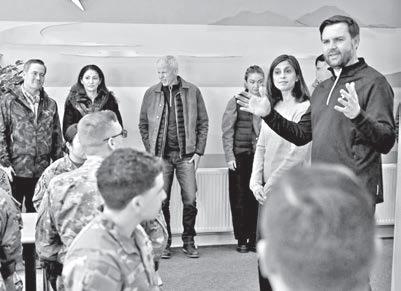
belongs to the Greenlanders.
Initially, Vance’s wife, Usha Vance, had announced a solo trip to the Avannaata Qimussersu dogsled race in Sisimiut. The vice president s ubsequently said he would join her on that trip, only to change that itinerary again—after pro -

tests from Greenland and Denmark—to a oneday visit to the military post only.
Inhabitants of Nuuk, which is about 1,500 kilometers (930 miles) south of Pituffik, voiced concern about Vance’s visit and the US interest in their island.
Cora Høy, 22, said Vance was “welcome if he wants to see it but of course Greenland is not for sale.” She added that “it’s not normal around here” with all the attention Greenland is getting. “I feel now every day is about (Trump) and I j ust want to get away from it.”
“It’s all a bit crazy. Of course, the population here is a bit shook up,” said 30-year-old I nuk Kristensen. “My opinion is the same as everyone’s: Of course, you don’t do things this
way. You don’t just come here and say that you want to buy the place.”
As the nautical gateway to the Arctic and North Atlantic approaches to North America, Greenland has broader strategic value as both China and Russia seek access to its waterways and natural resources.
“We need to ensure that America is leading in the Arctic, because we know that if America doesn’t, other nations will fill the gap where we fall behind,” Vance said.
Grieshaber reported from Berlin and Madhani from Washington. Associated Press writers Geir Moulson in Berlin and Vanessa Gera in Warsaw, Poland, contributed to this report.
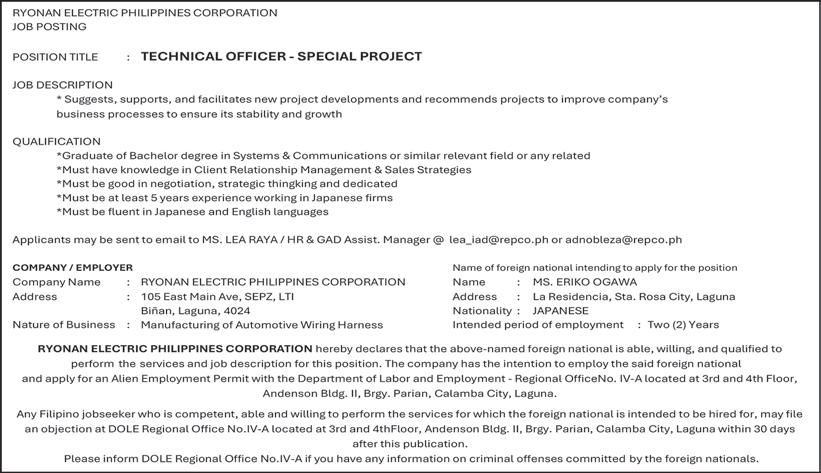
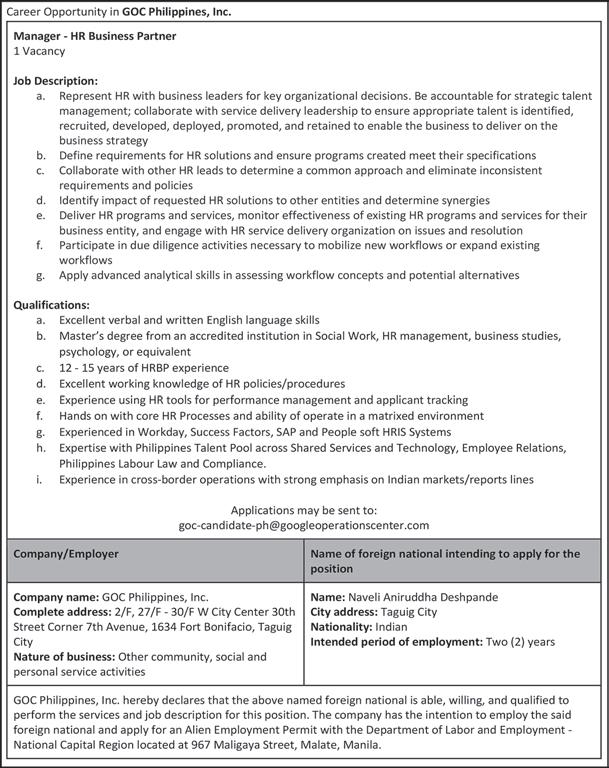

By Wafaa Shurafa, Samy Magdy, Sarah El Deeb & Lee Keath
The Associated Press
DEIR AL-BALAH, Gaza Strip—Gaza’s bakeries will run out of flour for bread within a week, the UN says. Agencies have cut food distributions to families in half. Markets are empty of most vegetables. Many aid workers cannot move around because of Israeli bombardment.
For four weeks, Israel has shut off all sources of food, fuel, medicine and other supplies for the Gaza Strip’s population of more than 2 million Palestinians. It’s the longest blockade yet of Israel’s 17-month-old campaign against Hamas, with no sign of it ending.
Aid workers are stretching out the supplies they have but warn of a catastrophic surge in severe hunger and malnutrition. Eventually, food will run out completely if the flow of aid is not restored, because the war has destroyed almost all local food production in Gaza.
“We depend entirely on this aid box,” said Shorouq Shamlakh, a mother of three collecting her family’s monthly box of food from a UN distribution center in Jabaliya in northern Gaza. She and her children reduce their meals to make it last a month, she said. “If this closes, who else will provide us with food?”
The World Food Program said Thursday that its flour for bakeries is only enough to keep producing bread for 800,000 people a day until Tuesday and that its overall food supplies will last a maximum of two weeks. As a “last resort” once all other food is exhausted, it has emergency stocks of fortified nutritional biscuits for 415,000 people.
Fuel and medicine will last weeks longer before hitting zero. Hospitals are rationing antibiotics and painkillers. Aid groups are shifting limited
fuel supplies between multiple needs, all indispensable—trucks to move aid, bakeries to make bread, wells and desalination plants to produce water, hospitals to keep machines running.
“We have to make impossible choices. Everything is needed,” said Clémence Lagouardat, the Gaza response leader for Oxfam International, speaking from Deir al-Balah in central Gaza at a briefing Wednesday. “It’s extremely hard to prioritize.”
Compounding the problems, Israel resumed its military campaign on March 18 with bombardment that has killed hundreds of Palestinians, mostly women and children, according to health officials. It has hit humanitarian facilities, the U.N. says. New evacuation orders have forced more than 140,000 Palestinians to move yet again.
But Israel has not resumed the system for aid groups to notify the military of their movements to ensure they were not hit by bombardment, multiple aid workers said. As a result, various groups have stopped water deliveries, nutrition for malnourished children and other programs because it’s not safe for teams to move.
COGAT, the Israeli military body in charge of coordinating aid, said the system was halted during the ceasefire. Now it is implemented in some areas “in accordance with policy and operational assessments ... based on the situation on the ground,” COGAT said, without elaborating.
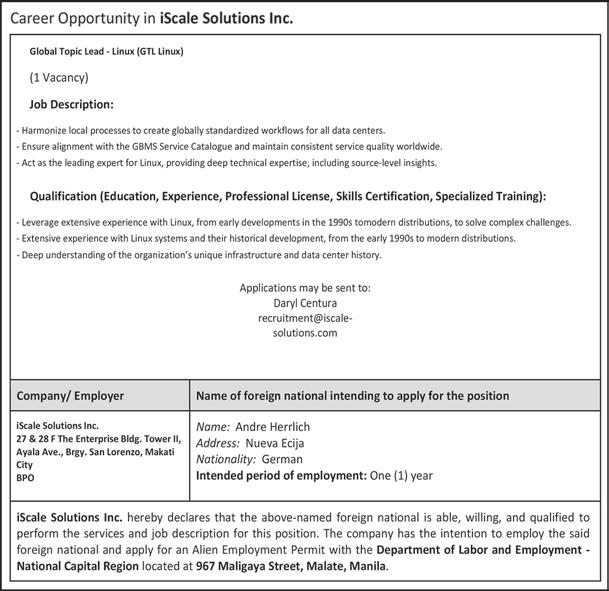


DURING the 42 days of ceasefire that began in mid-January, aid groups rushed in significant amounts of aid. Food also streamed into commercial markets.
But nothing has entered Gaza since Israel cut off that flow on March 2.
Israel says the siege and renewed military campaign aim to force Hamas to accept changes in their agreed-on ceasefire deal and release more hostages.
Fresh produce is now rare in Gaza’s markets. Meat, chicken, potatoes, yogurt, eggs and fruits are completely gone, Palestinians say.
Prices for everything else have skyrocketed out of reach for many Palestinians. A kilo (2 pounds) of onions can cost the equivalent of $14, a kilo of tomatoes goes for $6, if they can be found. Cooking gas prices have spiraled as much as 30-fold, so families are back to scrounging for wood to make fires.
“It’s totally insane,” said Abeer alAker, a teacher and mother of three in Gaza City. “No food, no services. … I believe that the famine has started again. “
Families depend even more on aid AT the distribution center in Jabaliya, Rema Megat sorted through the food
ration box for her family of 10: rice, lentils, a few cans of sardines, a half kilo of sugar, two packets of powdered milk.
“It’s not enough to last a month,” she said. “This kilo of rice will be used up in one go.”
The U.N. has cut its distribution of food rations in half to redirect more supplies to bakeries and free kitchens producing prepared meals, said Olga Cherevko, spokesperson for the UN humanitarian agency, known as OCHA.
The number of prepared meals has grown 25 percent to 940,000 meals a day, she said, and bakeries are churning out more bread. But that burns through supplies faster.
Once flour runs out soon, “there will be no bread production happening in a large part of Gaza,” said Gavin Kelleher, with the Norwegian Refugee Council.
UNRWA, the main UN agency for Palestinians, only has a few thousand food parcels left and enough flour for a few days, said Sam Rose, the agency’s acting director in Gaza.
Gaza Soup Kitchen, one of the main public kitchens, can’t get any meat or much produce, so they serve rice with canned vegetables, co-founder Hani Almadhoun said.
See “Gaza,” A9
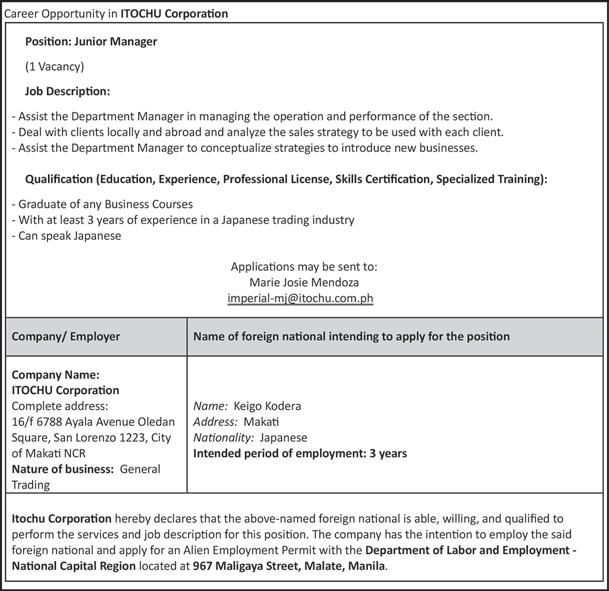
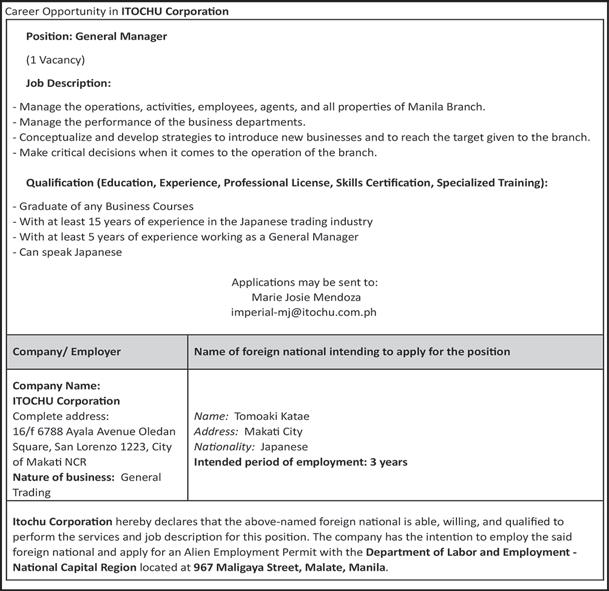
Ukraine warns of imminent Russian attack, accuses Kremlin of stalling ceasefire talks
By Samya Kullab The Associated Press
KYIV, Ukraine—Russian forces are preparing to launch a fresh military offensive in the coming weeks to maximize pressure on Ukraine and strengthen the Kremlin’s negotiating position in ceasefire talks, Ukrainian government and military analysts said.
The move could give Russian President Vladimir Putin every reason to delay discussions about pausing the fighting in favor of seeking more land, the Ukrainian officials said this week, renewing their country’s repeated arguments that Russia has no intention of engaging in meaningful dialogue to end the war.
With the spring fighting season drawing near, the Kremlin is eyeing a multipronged push across the 1,000-kilometer (621-mile) front line, according to the analysts and military commanders.
Citing intelligence reports, Ukrainian President Volodymyr Zelenskyy said Russia is getting ready for new offensives in the northeast in the Sumy, Kharkiv and Zaporizizhia regions.
“They’re dragging out the talks and trying to get the US stuck in endless and pointless discussions about fake ‘conditions’ just to buy time and then try to grab more land,” Zelenskyy said Thursday in a visit to Paris.
Two G7 diplomatic officials in Kyiv agreed with that assessment. They spoke on condition of anonymity because they were not authorized to brief the press.
Russia has effectively rejected a US proposal for an immediate and full 30-day halt in the fighting, and the feasibility of a partial ceasefire on the Black Sea was thrown into doubt after Kremlin negotiators imposed far-reaching conditions.
Four people died and 24 were injured Friday evening after Russian drones struck Dnipro in the country’s east, according to regional Gov. Serhii Lysak and Ukraine’s emergency service. At least eight more people were injured when a Russian ballistic missile struck nearby Kryvyi Rih, Zelenskyy’s hometown, Gov. Lysak reported.
Battlefield success is clearly in Putin’s mind.
“On the entire front line, the strategic initiative is completely in the hands of the Russian armed forces,” Putin said Thursday at a forum in the Arctic port of Murmansk.
“Our troops, our guys are moving forward and liberating one territory after another, one settlement after another, every day.” Kremlin forces keep pressing forward
Ukrainian military commanders said Russia recently stepped-up attacks to improve its tactical positions ahead of the expected broader offensive.
“They need time until May, that’s all,” said Ukrainian military analyst Pavlo Narozhnyi, who works with soldiers and learns about intelligence from them.
In the north, Russian and North Korean soldiers have nearly deprived Kyiv of an essential bargaining chip by retaking most of Russia’s Kursk region, where Ukrainian soldiers staged a daring incursion last year. Battles have also escalated along the eastern front in Donetsk and Zaporizhzhia. A concern among some commanders is whether Russia might divert battle-hardened forces from Kursk to other parts of the east.
“It will be hard. The forces from Kursk will come on a high from their wins there,” said a Ukrainian battalion commander in the Donetsk region, who spoke on condition of anonymity to describe his concerns.
“They are preparing offensive actions on the front that should last from six to nine months, almost all of 2025,” said Ukrainian military analyst Oleksii Hetman, who has connections to the military’s general staff.
Fighting intensifies on parts of the front line
RUSSIA entered negotiations with a clear advantage in the war. Now, after recapturing 80 percent of its territory in the Kursk region ahead of talks, its forces have intensified their fighting across other parts of the front line.
“The number of clashes on the front line is not decreasing,” Hetman said. “If they wanted to stop the war, their actions certainly don’t show it.” Russia ramped up reconnaissance mis -
sions to find and destroy firing positions, drone systems and other capabilities that could impede a future onslaught, two Ukrainian commanders said.
“These can be all signs that an attack is being prepared in the near future,” Hetman said.
The Russian Defense Ministry on Saturday also claimed that its troops had taken a village in Ukraine’s Sumy region, across the border from Kursk. Zelenskyy earlier named the province as one of the targets for a Russian spring offensive. The Russian claim could not be independently verified, and Ukraine did not comment.
Fighting also intensified in the eastern city of Pokrovsk, one of Ukraine’s main defensive strongholds and a key logistics hub in the Donetsk region. Its capture would bring Russia closer to its stated aim of capturing the entire region.
“The Russians were significantly exhausted over the past two months. During 10 days of March, they took a sort of pause,” military spokesman Maj. Viktor Trehubov said of the situation in Pokrovsk. In midMarch, the attack resumed. “This means the Russians have simply recovered.” Russia increases reconnaissance missions
A Ukrainian soldier with the call sign “Italian” said Russia was conducting intensive reconnaissance in his area of responsibility in the Pokrovsk region. Radio intercepts and intelligence show a buildup of forces in the area around Selidove, a city in the Pokrovsk region, and the creation of ammunition reserves, he said. The buildup includes large armored vehicles, and the many new call signs overheard in radio transmissions suggest that fresh forces are coming in, he said.
Farther south, a military blog run by Mikhail Zvinchuk, a former officer of the Russian Defense Ministry’s press section, noted last week that Russian troops recently unleashed a new offensive west of Orikhiv in the Zaporizhzhia region.
The offensive will allow Russian forces to move toward the city of Zaporizhzhia and “force the enemy to redeploy its troops from other sectors, leaving Robotyne and Mala Tokmachka badly protected,” the blog known as Rybar said, adding that the new offensive “could be the first step toward the liberation of the Zaporizhzhia region.”
On Friday, Vladyslav Voloshyn, a spokesman for the Southern Defense Forces of Ukraine, said the situation in the region is fraught after Russia amassed more forces to conduct assaults with small groups of infantries.
Russian analysts project optimism that a future offensive will succeed.
“Both sides are actively preparing for the spring-summer campaign,” Sergey Poletaev, a Moscow-based military analyst, wrote in a recent commentary. “There’s a growing sense that the Ukrainian forces may be struggling to prepare for it adequately.”
Little progress reported at negotiating table
Meanwhile at the negotiating table, Russian demands have curtailed the results of much-anticipated negotiations brokered by the US.
Earlier this month, after Russia effectively turned down the US proposal for a complete, monthlong halt in the fighting, Moscow tentatively agreed to a partial ceasefire on Black Sea shipping routes. But that agreement was quickly cast into doubt by Russia’s insistence on farreaching conditions that its state bank be reconnected to the SWIFT international payment system, something Kyiv and the EU rejected outright. Along the front line, the reported ups and downs of the talks fuel frustration and worry.
“No one believes in them,” said the Ukrainian soldier known as Italian, who spoke on the condition that he be identified only by his call sign in keeping with military protocol. “But there is still hope that the conflict will move in another direction. Everyone is waiting for some changes in the combat zone because it is not good for us now. We really don’t want to admit that.”
By Michael Liedtke
AP Business Writer
AN FRANCISCO—Protesters against billion -
Saire Elon Musk’s purge of the US government under President Donald Trump demonstrated outside Tesla dealerships throughout the US and in some cities in Europe on Saturday in the latest attempt to dent the fortune of the world’s richest man.
The protesters were trying to escalate a movement targeting Tesla dealerships and vehicles in opposition to Musk’s role as the head of the newly created Department of Government Efficiency, or DOGE, where he has gained access to sensitive data and shuttered entire agencies as he attempts to slash government spending. The biggest portion of Musk’s estimated $340 billion fortune consists of his stock in the electric vehicle company, which continues to run while also working alongside Trump. After earlier demonstrations that were somewhat sporadic, Saturday marked the first attempt to surround all 277 of the automaker’s showrooms and service centers in the US in hopes of deepening a recent decline in the company’s sales. By early afternoon crowds ranging from a few dozen to hundreds of protesters had flocked to Tesla locations in New Jersey, Massachusetts, Connecticut, New York, Maryland, Minnesota and the automaker’s home state of Texas. Pictures posted on social media showed protesters brandishing signs such as “ Honk if you hate Elon “ and “ Fight the billionaire broligarchy.”
As the day progressed, the protests cascaded around the country outside Tesla locations in major cities such as Washington, Chicago, Indianapolis, Cincinnati and Seattle, as well as towns in Virginia, Pennsylvania and Colorado. Smaller groups of counterprotesters also showed up at some sites.
“Hey, hey, ho, ho, Elon Musk has got to go!” several dozen people chanted outside a showroom in Dublin, California, about 35 miles (60 miles) east of San Francisco, while a smaller cluster of Trump supporters waved American flags across the street.
A much larger crowd circled another showroom in nearby Berkeley, chanting slogans to the beat of drums. “We’re living in a fascist state,” said Dennis Fagaly, a retired high school teacher from neighboring Oakland, “and we need to stop this or we’ll lose our whole country and everything that is good about the United States.”
Anti-Musk sentiment extends beyond the US.
The Tesla Takedown movement also hoped to rally protesters at more than 230 locations in other parts of the world. Although the turnouts in Europe were not as large, the anti-Musk sentiment was similar.
About two dozen people held signs lambasting the billionaire outside a dealership in London as passing cars and trucks tooted horns in support.
One sign displayed depicted Musk next to an image of Adolf Hitler making the Nazi salute—a gesture that Musk has been accused of reprising shortly after Trump’s Jan. 20 inauguration. A person in a Tyrannosaurus rex costume held another sign with a picture of Musk’s straight-arm gesture that said, “You thought the Nazis were extinct. Don’t buy a Swasticar.”
“We just want to get loud, make noise, make people aware of the problems that we’re facing,” said Cam Whitten, an American who showed up at the London protest.
Tesla Takedown was organized by a group of supporters that included disillusioned owners of the automaker’s vehicles, celebrities such as ac-
tor John Cusack, and at least one Democratic Party lawmaker, Rep. Jasmine Crockett from Dallas.
“I’m going to keep screaming in the halls of Congress. I just need you all to make sure you all keep screaming in the streets,” Crockett said during an organizing call this month.
Another Democratic lawmaker, Rep. Pramila Jaypal, showed up at a protest in Seattle, which she represents in Congress.
Musk backlash has included some vandalism
SOME people have gone beyond protest, setting Tesla vehicles on fire or committing other acts of vandalism that US Attorney General Pam Bondi has decried as domestic terrorism. In a March 20 company meeting, Musk indicated that he was dumbfounded by the attacks and said the vandals should “stop acting psycho.”
Crockett and other Tesla Takedown supporters have been stressing the importance of Saturday’s protests remaining peaceful.
But police were investigating a fire that destroyed seven Teslas in northwestern Germany in the early morning. It was not immediately clear if the blaze, which was extinguished by firefighters, was related to the protests.
In Watertown, Massachusetts, local police reported that the side mirror of a black pickup struck two people at a protest outside a Tesla service center, according to the Boston Herald. The suspect was promptly identified by police at the scene, who said there were no serious injuries.
Musk maintains that the company’s future remains bright
A GROWING number of consumers who bought Tesla vehicles before Musk took over DOGE have been looking to sell or trade them in, while others have slapped on bumper stickers seeking to distance themselves from him.
But Musk did not appear concerned about an extended slump in new sales in the March meeting, during which he reassured the workers that the company’s Model Y would remain “the bestselling car on Earth again this year.” He also predicted that Tesla will have sold more than 10 million cars worldwide by next year, up from about 7 million currently.
“There are times when there are rocky moments, where there is stormy weather, but what I am here to tell you is that the future is incredibly bright and exciting,” Musk said.
After Trump was elected last November, investors initially saw Musk’s alliance with the president as a positive development for Tesla and its long-running efforts to launch a network of self-driving cars.
That optimism helped lift Tesla’s stock by 70 percent between the election and Trump’s January 20 inauguration, creating an additional $560 billion in shareholder wealth. But virtually all those gains have evaporated amid investor worries about the backlash, lagging sales in the US, Europe and China, and Musk spending time overseeing DOGE.
“This continues to be a moment of truth for Musk to navigate this brand tornado crisis moment and get onto the other side of this dark chapter for Tesla,” Wedbush Securities analyst Dan Ives said in a recent research note.
Associated Press writers Terry Chea in Berkeley, California, Mustakim Hasnath in London and Stefanie Dazio in Germany contributed.
children, said Rachael Cummings, the group’s humanitarian response leader in Gaza.
“We are expecting an increase in the rate of malnutrition,” she said. “Not only children— adolescent girls, pregnant women.”
By Colleen Barry | The Associated Press
ROME—Pope Francis’ frailty was on full view as he left Rome’s Gemelli hospital last Sunday after five weeks battling pneumonia that nearly killed him. He could barely lift his arms to bless the crowd. His eyes were sunken, face bloated. And he visibly gasped for breath as he was wheeled back inside from the balcony.
Throughout history, the powerful have concealed their weaknesses. Kaiser Wilhelm II of Germany, the most photographed figure of his era, took pains to hide his lame arm. Franklin Delano Roosevelt concealed the use of a wheelchair.
More recently, former President Biden shook off concerns about his cognitive abilities.
By contrast, Francis, a spiritual and not political leader, has never been shy about showing his weakness. For many, his willingness to be seen in all his infirmity serves as an example to young and old alike that fragility is part of the human condition—and should be embraced.
“Who cares if he had sunken eyes, who cares if he looks bloated. It is part of his life story. He knows it is going to end. I saw him as living his life. He wants to keep doing what he does best,’’ said S. Jay Olshansky, a gerontologist at the University of Illinois at Chicago.
Francis’ frailty is integral to his ministry of inclusion, which preaches against treating people on the margins as disposable,
said Archbishop Vincenzo Paglia, president of the Pontifical Council for Life.
“Fragility for us believers is not to be avoided or excluded. On the contrary it is a great teaching,’’ Paglia said in an interview. “It is in sharp contrast with an efficiencyoriented culture, with a performance culture.’’
“This is not a state, or a company, it is a community of the faithful, a family. And in a family, it is possible to give an authoritative leadership, also if not up to full physical strength,’’ Paglia said. He added that it was an important lesson also for young people “who should understand that they too are fragile, otherwise they close themselves off.’’ Paglia this week opened a longevity summit at the Vatican, during which he underlined that as the population of elderly grows, there must be an attitude shift so that the longer life span is to be lived to its fullest.
“We need to rethink the idea of retirement. These 20, 30 years more must have also a cultural,

human and spiritual weight for all the other ages. They are not disposable,’’ he said.
Dr. Francesco Vaia, an advocate of rights for the disabled, also said the pope’s message is especially crucial in an aging world.
“The theme is not only to get older, but to be active, that is to give more quality to our longer lives,’’ he said. “We are moving towards an inclusive society,’’ which is in contrast with a “throw-away world in which the weak, the disabled, the elderly are pushed aside.’’
“Let’s overcome the superman and superwoman theory. We are men and women with our fragility, and disabilities,’’ Vaia said. “This pope can continue being pope.
Even the fact of seeing Francis with the nasal breathing tubes as he was driven to the Vatican normalizes a fact of life for many elderly who live with oxygen tanks. “We should not be ashamed of this,’’ Vaia said.
Pope John Paul II, too, was often praised for showing his suffering during his long bout with Parkinson’s disease. But the Vatican also went to great lengths to conceal
his frailty. He was never seen in a wheelchair, for example, instead he was pushed on a rolling wooden chair or upon a moving platform. Francis by contrast arrives at events in wheelchairs, and is seen lifted into a more formal seat for Masses or to address the faithful. He did not shy away from showing his weakened state from the hospital. An audio recording of his barely audible, labored voice was played in St. Peter’s Square three weeks into his hospitalization as a first sign of life. It was followed by a photograph of him co-celebrating Mass, taken from behind in his personal hospital chapel.
While Francis’ appearance on the hospital balcony did not necessarily project vitality, the doctor who coordinated his hospital treatment saw it as a sign of his strength.
“You saw when he looked out, he is fragile. But his strength is that he could give, even with some difficulty, the blessing,’’ Dr. Sergio Alfieri said. “He looked at the square, and he welcomed the lady with the yellow flowers, as if to say, ‘I am maintaining a good mood.’ He is strong in this sense, a strong spirit.”
“There are a lot more people showing up, and they’re more desperate. So, people are fighting for food,” he said.
Israel shows no sign of lifting the siege THE United States pressured Israel to let aid into Gaza at the beginning of the war in October 2023, after Israel imposed a blockade of about two weeks. This time, it has supported Israel’s policy. Rights groups have called it a “starvation policy” that could be a war crime.
Israeli Foreign Minister Gideon Saar told a news conference Monday that “Israel is acting in accordance with international law.”
He accused Hamas of stealing aid and said Israel is not required to let in supplies if it will be diverted to combatants.
He gave no indication of whether the siege could be lifted but said Gaza had enough supplies, pointing to the aid that flowed in during the ceasefire.
Hunger and hopelessness are growing
BECAUSE its teams can’t coordinate movements with the military, Save the Children suspended programs providing nutrition to malnourished
During the ceasefire, Save the Children was able to bring some 4,000 malnourished infants and children back to normal weight, said Alexandra Saif, the group’s head of humanitarian policy.
About 300 malnourished patients a day were coming into its clinic in Deir al-Balah, she said. The numbers have plunged—to zero on some days—because patients are too afraid of bombardment, she said.
The multiple crises are intertwined. Malnutrition leaves kids vulnerable to pneumonia, diarrhea and other diseases. Lack of clean water and crowded conditions only spread more illnesses. Hospitals overwhelmed with the wounded can’t use their limited supplies on other patients.
Aid workers say not only Palestinians, but their own staff have begun to fall into despair.
“The world has lost its compass,” UNRWA’s Rose said. “There’s just a feeling here that anything could happen, and it still wouldn’t be enough for the world to say, this is enough.”
Magdy and Keath reported from Cairo, El Deeb from Beirut. AP correspondents Fatma
in Cairo and Julia
and Sam Mednick in Jerusalem contributed.
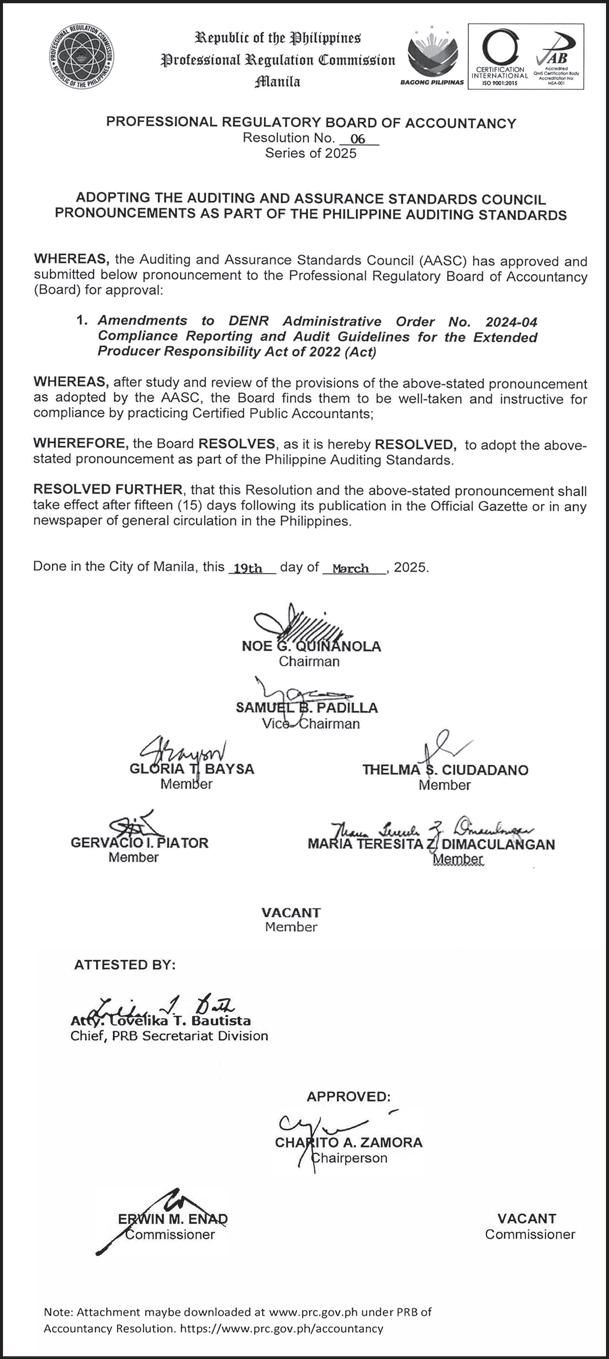
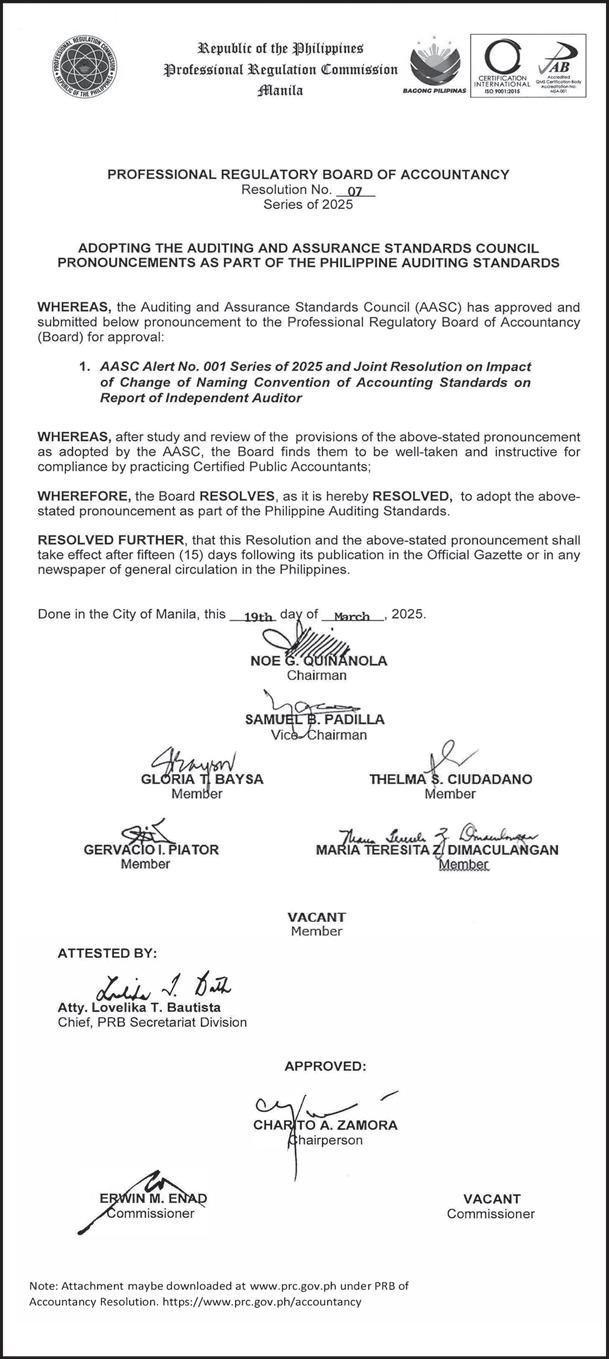


TBy Ada Pelonia @adapelonia
HE National Food Authority (NFA) said its “competitive buying price” allowed it to significantly raise its purchases of paddy rice in February.
The grains agency said it procured 412,052 50-kilo bags or 20,602.6 metric tons (MT) of palay last month, a big jump from the 12,378 bags or 618.9 MT it bought in February 2024.
Despite this, the NFA noted that it failed to meet its procurement target of 429,600 bags or 21,480 MT for February.
weekly per province.
Meanwhile, the NFA said it had a total rice inventory of 6 million bags or 300,023 MT at the end of February.
“It should be noted that NFA’s inventory is 14 percent of the country’s national rice inventory.”
The agency distributed 48,179 bags or 2,409 MT of milled rice during the reference month, 12.75 percent of its target of 377,820 bags or 18,891 MT, despite the declaration of a food security emergency.
Under the grains agency’s program, the NFA buys clean and dry palay at P23 to P30 per kilo, while the price of fresh and wet palay ranges from P17 to P23 per kilo. This flexible price scheme changes
“Increase in procurement compared to last month is mainly due to the on-set of harvest season, and the implementation of the Council-approved Price Range Scheme [PRICERS] for palay procurement activity,” the NFA said in its latest accomplishment report.
‘Govt projects aim to improve access to markets of ARBs’
By Jonathan L. Mayuga @jonlmayuga

HE Department of Agrarian Reform
T(DAR) said it completed a farm-tomarket road and turned over farm equipment to agrarian reform beneficiaries (ARBs) in Luzon and Mindanao.
In Sitio Lomon, Kapangan, Benguet, DAR said 769 ARBs will benefit from better road access and economic opportunities with the completion of the P10-million Labueg-Tabaao Farm-to-Market Road (FMR).
“The 1.267-kilometer FMR will significantly ease the transportation of agricultural products, reduce post-harvest losses, and improve market access, allowing farmers to sell their goods more efficiently.”
DAR Project Management Services (PMS)
OIC-Director IV Von Mark R. Mendoza said the project “ensure better livelihood and improved quality of life” of the recipients.
“This is a testament to our commitment to making government programs more accessible, especially to our ARBs. The FMR is a bridge to better opportunities for our ARBs.” DAR Secretary Conrado M. Estrella III said the FMR reaffirms the agency’s commitment to improving the quality of life of ARBs, especially in remote farming communities across the country.
Kapangan Mayor Manny Fermin expressed gratitude to the DAR and the Department of Public Works and Highways (DPWH) for their support, highlighting the importance of inter-agency collaboration in bringing development to the grassroots level.
In the Cordillera Administrative Region, DAR Regional Director Samuel S. Solomero noted that the agency continues to implement programs that further support the ARBs, citing Project SPLIT, which secures
land tenure for ARBs, and the Value Chain Innovation for Sustainable Transformation in Agrarian Reform Communities (VISTA) Project, a six-year program focused on enhancing rural development, food security, and environmental sustainability.
In Bagumbayan, Sultan Kudarat, members of the Daluga Farmers Association (DFA) in Bagumbayan received a hauling truck worth P1.088 million from DAR through the Climate Resilient Farm Productivity Support (CRFPS) Program.
The new truck will significantly ease the transport of farm produce, reduce costs, and improve farm production.
“We remain dedicated to understanding the needs of our ARBs and providing support to help them thrive in a competitive market,”
Provincial Agrarian Reform Program Officer (PARPO) Abdullah N. Balindong said.
The CRFPS Program, funded under the Agrarian Reform Fund, aims to enhance farm productivity by providing FMEs to agrarian reform communities (ARCs). By reducing production costs and improving efficiency, the program helps increase ARBs’ incomes and strengthen the agricultural sector.
DAR turned over a communal irrigation system to ARBs in Asingan, Pangasinan. The upgraded irrigation system will benefit 80 ARBs and irrigate over 429 hectares of farmland. It replaced the old earth irrigation system, which suffered from significant water loss due to seepage. With a newly cemented irrigation system, water distribution is now more efficient, ensuring farmers get the water they need for increased productivity and higher yields.
DAR said it continues to invest in infrastructure projects that empower farmers, ensuring sustainable agriculture and a brighter future for rural communities.
THE world’s largest commodity traders are still making historically elevated profits, even as less-volatile markets mean their earnings have retreated from the bonanza that followed Russia’s full invasion of Ukraine.
At the FT Commodities Global Summit in Lausanne this week, executives at the largest trading houses and their bankers indicated both on stage and privately that although earnings for 2024 and the first quarter of 2025 would be lower than the boom years of 2022-2023, they remained higher than almost any other time in history.
The trading houses are some of the world’s largest companies measured by annual turnover, but most are privately owned
It distributed 1,179.6 MT of rice to the Department of Social Welfare and Development (DSWD), Office of Civil Defense (OCD), legislators, and local governments for relief operations and calamity response.
About 739.75 MT of rice were distributed to government agencies and local government units (LGU) rice requirement under the Executive Order 51 program, the
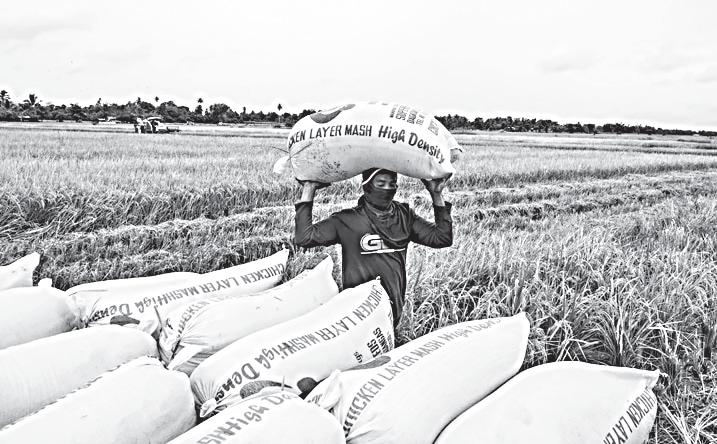
NFA said.
It added that 105 MT have been distributed to LGUs under the food security emergency program, which was declared to fast-track the release of rice buffer stocks held by the NFA.
This year, the NFA is targeting to procure as much as 880,000
MT of palay to meet its new buffer stock requirement of 15 days as stipulated under the amended Rice Tariffication Law (RTL).
Under the amended RTL, the NFA should maintain a buffer stock enough to cover 15 days of national rice consumption, up from the previous nine-day re -
quirement.
Last week, Agriculture Secretary Francisco Tiu Laurel Jr. said the NFA would need to procure some 20 percent of local supply to move the needle on palay prices. He said the grains agency is grappling with a limited budget which hampers it from purchasing “significant” volumes from farmers and managing rice inventories through regular sales to the public as it was stripped of its regulatory powers.
The NFA has been purchasing palay at P18 per kilo for fresh harvests and P24 per kilo for clean, dry grains, the Deparment of Agriculture said.
“With its limited authority, the NFA cannot intervene in the market effectively, leaving traders room to suppress palay prices,” he said. “This has led to the current farmgate prices dropping to as low as P14 per kilo.”
THE Philippines will soon ship raw sugar to the United States to fill part of its allocation under the tariff rate quota (TRQ) scheme of Washington.
Sugar Regulatory Administration (SRA) Administrator Pablo Luis Azcona said the agency has already notified its US counterpart of the shipment of 66,000 metric tons (MT) of raw sugar.
“We already informed the US that we’re exporting 66,235 [MT of raw sugar],” Azcona told reporters in a recent interview.
He said exporters are already booking a boat bound for the US so that the sugar will arrive in its “best condition” before the September 30 deadline.
The shipment is expected to arrive earlier than the raw sugar cargo that reached US soil on September 27 last year.
“This year, definitely they will be shipping out [during] the milling season. So, the sugar that will be shipped out will be of very good quality.”
Under Sugar Order (SO) 5, the SRA board has approved the outbound shipment of the sweetener, which is tied to the agency’s the voluntary purchase program under SO 2.
The voluntary purchase program stipulates that a portion of the 120,000 MT raw sugar purchased at a premium would be exported to the US as part of the TRQ allocation.
The export program would be open to qualified participants that availed of the 120,000 MT under the agency’s voluntary purchase program.
Last year, the Philippines was given an allocation of 145,235
metric tons raw value (MTRV) of raw cane sugar under the TRQ system for fiscal year 2025, which started on October 1, 2024, according to the US Trade Representative (USTR).
The Philippines got the thirdlargest TRQ allocation after the Dominican Republic’s 189,343 MTRV and Brazil’s 155,993 MTRV. The TRQ scheme allows countries to ship certain products to the US at a relatively low tariff.
For this year, the volume for shipment is higher than the 24,179 MT exported by Philippine producers to the US in 2024.
Meanwhile, the order stipulates that eligible participants would be given priority in future import programs at a ratio of 1 (raw sugar exported):2.5 (imported refined sugar).
By Lenie Lectura @llectura

HERMA Luzon Inc.
T(TLI) has inaugurated a seaweed processing facility in Pagbilao, Quezon that aims to enable women in the area to go into product development while promoting marine conservation.
The facility will be managed by the Samahan ng mga Kababaihan ng Banlisan at Pantoc (SKBP).
“This facility is a game-
changer for our coastal communities. It reinforces the importance of responsible marine resource management,” said Francia Nardo Astejada, Fisheries Chief of the Quezon Provincial Agriculture Office.
The SKBP members will process seaweed into various value-added products such as noodles, kropek, and atsara, supporting both economic growth and sustainable food production. An increase in the marketability of locally produced seaweed is projected,
traders still rake in billions as
by founders and employees, and many don’t report their results publicly. The industry has enjoyed an enormous windfall since the invasion of Ukraine and the energy crisis that followed it, with combined profits of more than $50 billion in 2022 and 2023 at the four leading privately-owned energy traders — Vitol Group, Trafigura Group, Mercuria Energy Group Ltd. and Gunvor Group.
Commodity traders thrive on volatility and high prices, and both have retreated from the extremes of 2022. But the industry is still benefitting from disruptions to trade flows ranging from tariffs and sanctions to the crisis in the Red Sea, while the biggest players are also beginning to reap the rewards of
billions of dollars invested in assets and diversification into new markets, helping to cushion the decline in trading profits.
Vitol’s profit for 2024 was lower than the previous year’s level of $13.2 billion, but not drastically so, according to people briefed on the results, who asked not to be identified because the information is not public.
Trafigura, which saw annual earnings peak above $7 billion in 2022-2023, is on track for net profit for the half year ending in March that’s roughly in line with the past two reporting periods, when it posted half-year profits of $1.5 billion and $1.3 billion, other people familiar with the matter said. The people cautioned that the company’s accounts have
not yet been finalized and things could yet change.
At the conference this week, Trafigura Chief Financial Officer Stephan Jansma said that the company’s financial performance had “reached a new cruising altitude.”
“That cruising altitude is significantly less than the two years which were very high profitability, but also it’s significantly higher than the profitability we had before the Covid period,” he said.
Mercuria sees its earnings stabilizing at an annual rate of about $1.5 billion to $2 billion, according to a person familiar with the matter. The company made $2.1 billion in its financial year ending September 2024, Bloomberg has reported previously. That is lower
with products to be offered through FISH-Coop catering services and the Kadiwa store, further boosting the local economy.
“Through this project, we are not just earning a living— we are protecting our marine resources and securing a better future for our families,” said Renalyn Cañares, President of SKBP.
Azcona said the glut in sugar supply in the first quarter pulled down farmgate prices.
“So, to create a need and a demand and to stabilize the price, we export and then once we have a [supply gap], we import when harvest is done to replenish the export,” he said in a previous interview.
“We are thinking of a total import [volume] for the export replenishment of about 165,000 MT of refined sugar. So, [the exporters] can make up for the difference in cost.”
Currently, Azcona said the agency promised sugarcane farmers that it would not issue an import program until May or June.
“Until we get the accurate production data, we cannot come up with an import sugar order yet.”
Ada Pelonia
TLI said the facility, which integrates livelihood opportunities with conservation efforts, can drive “meaningful business and community change.”
The company partnered with the the Quezon Provincial Agriculture Office, the Bureau of Fisheries and Aquatic Resources and the Local Government Unit of Pagbilao for the facility. This project was developed under TLI’s earlier Giant Clam Conservation Project, an initiative that aims to protect marine biodiversity, restore overexploited reef flats, and provide sustainable livelihoods for local fishers through giant clam propagation and ecotourism.
than record profits of $3 billion in 2022, but far higher than any annual profit before then. Until 2021, Mercuria had never made more than $1 billion in a year.
Mercuria, Trafigura and Vitol all declined to comment.
Gunvor took some losses in the oil market last year — including a bullish play in the North Sea crude market that went wrong — but will still report the fourth or fifth best result in its history for 2024, Chief Executive Officer Torbjörn Törnqvist said in an interview.
Vitol expects that margins and profitability are resetting at a higher level than before the pandemic, but below the recent boom, CEO Russell Hardy said at the conference. Despite the torrent of news, commodity markets have
become “more bounded,” he said.
“The world is changing,” Hardy said. “The rhetoric — sanctions, tariffs, et cetera — is higher, but the reality is the volatility is lower.”
The trading companies are handing a significant chunk of their giant profits to their own shareholders, while also investing in assets like power plants and oil refineries, and diversifying into new markets like metals.
“We’re now looking at five to 10 projects where the size of the ticket would be half a billion dollars or more,” Mercuria CEO Marco Dunand told the conference. “And that’s something we certainly could not afford to do without this extra profit.” Bloomberg News
A matter of when, not if: Are we ready for the ‘Big One’?
THE devastating earthquake that struck Myanmar and Bangkok on Friday, leaving a trail of death and destruction, serves as a stark and urgent reminder of the ever-present threat of seismic activity in Southeast Asia. While our hearts go out to the victims and their families, this tragedy must also serve as a critical wake-up call for the Philippines. We must ask ourselves: Are we truly prepared for “The Big One”?
The Philippines, situated along the Pacific Ring of Fire, is no stranger to earthquakes. The 1990 Luzon earthquake, a magnitude 7.8 tremor, resulted in widespread devastation and a tragic loss of life. Similarly, the 2013 Bohol earthquake, with a magnitude of 7.2, caused significant damage and claimed hundreds of lives. These events, while devastating, should have been lessons learned. Yet, have we truly internalized these lessons and taken the necessary steps to mitigate the impact of a future, potentially larger, earthquake?
Myanmar’s death toll from Friday’s powerful earthquake passed 1,600 amid extensive damage in the second-largest city of Mandalay. The 7.7-magnitude earthquake, Myanmar’s biggest in a century, also injured more than 2,300 people, according to the State Administration Council. Authorities said about 2,300 buildings, including homes and temples collapsed in Mandalay.
In neighboring Thailand, rescuers are still searching for dozens of people missing from a collapsed 30-story building that was under construction in Bangkok. An investigation is underway and officials will report their findings within a week, Prime Minister Paetongtarn Shinawatra said. Authorities in Bangkok said 11 people were killed and about 100 are missing. Thailand’s Disaster Prevention and Mitigation Department said 57 of 77 provinces in the country felt the tremors, while damage has been reported in 13 of them.
Bangkok city authorities have also ordered safety audit of public and government buildings, Bangkok Governor Chadchart Sittipunt said. Three hospitals in Bangkok were inspected on Friday night and one of them, Ratwithi Hospital, was instructed not to use the building due to damage from the earthquake, according to authorities.
While the Philippines has made some progress in disaster preparedness, as evidenced by the quarterly Nationwide Simultaneous Earthquake Drills and the development of tools like the Rapid Earthquake Damage Assessment System (REDAS), much more needs to be done.
To prepare for a massive earthquake, we must address several critical areas. We need to strictly enforce building codes to ensure new construction meets earthquake resistance standards and retrofit existing buildings where necessary.
Public awareness and education campaigns are essential to inform citizens about earthquake safety measures and evacuation procedures. Investment in resilient infrastructure, such as hospitals and transportation networks, is crucial, as is improving emergency response capabilities, including search and rescue, medical supplies, and communication coordination. Devastating earthquakes are an inevitable part of the country’s future. The only question is whether the government and our people will be ready when the ground starts to shake. Survival in the face of a catastrophic event depends on one thing: being ready. Preparing for the worst is not a choice, it is an absolute necessity.


N February, Vice President Sara Duterte became the first VP in Philippine history to be impeached, accused of corruption and insurrection. Shortly after, another unprecedented event shook the nation: the arrest of former President Rodrigo Duterte by the International Criminal Court (ICC) for alleged crimes against humanity linked to his controversial “war on drugs.” These developments have heightened political tensions as the country prepares for midterm elections. Amid this political turbulence, one pressing question emerges: How will these events affect our economy?
lower inflation rates and recent monetary policy easing—remain strong enough to attract interest from global players who are looking beyond the current instability.
V. Ramos Aldwin Maralit Tolosa
Rolando M. Manangan


Despite the chaos in government, there’s one silver lining for the economy: election spending. With over P6.3 trillion allocated for 2025, campaign-related activities are expected to inject significant cash into local economies. Historically, election years have boosted GDP growth due to heightened consumer spending and infrastructure projects tied to campaign promises. This year is no different—analysts predict growth rates exceeding 6 percent, driven by household consumption and capital formation.
While political scandals may unsettle local markets temporarily, foreign investors appear cautiously optimistic about long-term prospects. The Philippines’ fundamentals—
To thrive in an unpredictable environment, businesses must closely monitor policy shifts, such as tax reforms like the “Create More Act” (RA 12066) and infrastructure budgets that directly impact operations. Diversifying supply chains is another key strategy to mitigate risks from global trade wars, which can be achieved by forging partnerships within Asean markets. Companies can also capitalize on hybrid work models by tapping into provincial talent pools, especially as Metro Manila remains politically sensitive. Lastly, advocating for stability is essential; business organizations should push for clarity on constitutional amendments that could reshape foreign investment rules and economic policies.
The upcoming midterm elections on May 12, 2025 represent a pivotal moment for the Philippines, with over 68 million registered voters
set to elect more than 18,000 officials across national and local levels. Historically, such elections serve as a referendum on the sitting president’s administration, and this year is no exception. President Marcos, halfway through his term, faces challenges ranging from inflation and income inequality to climate resilience and national security concerns. The stakes are high, as these elections will shape governance priorities and reform momentum leading up to the 2028 presidential race. For businesses, agility is key— not only in navigating immediate election-driven impacts like increased spending but also in preparing for post-election shifts that could redefine opportunities across sectors such as agriculture, trade, and infrastructure. While political tensions dominate headlines, Filipino businesses have consistently demonstrated resilience, adapting to uncertainty and driving economic growth even in turbulent times. This resilience will be crucial as the nation charts its course through a politically charged landscape.
The moral failure of PhilHealth: How idle funds betray the promise of universal healthcare

THERE is a disconnect between the divergence in voices over the idle funds of Philippine Health Insurance Corp (PhilHealth). These funds, which came from contributions to the health insurance, sit idle in banks, generating no interest, languishing in limbo instead of being used to provide crucial healthcare for millions of Filipinos. This is not just a financial misstep—it’s a moral failing. And to think that there is about P510 billion in idle funds sitting in PhilHealth banks.
That huge amount invites attention. As these funds stagnate, the very people who need healthcare the most, especially the poor, are left without the support they need to secure their health. This disconnect between available funds and unmet needs is not only troubling— it’s unacceptable. Something is profoundly wrong here. After all, the most expensive money is unused or unutilized funds. Money that should have gone to meeting the health challenges of the populace, most especially the poor. For years, the issue has been drowned out by noise—loud criticisms of the government’s decision to transfer PhilHealth’s idle funds
to the national treasury, to be repurposed for various government programs, many of them health-related. But noise is not evidence, and repetition is not proof. The real problem, obscured by all the clamor, is this: PhilHealth, despite accumulating billions of pesos, has failed to deliver a coherent, actionable roadmap for universal healthcare. The agency’s inefficiency is not speculation—it is a fact, proven by the billions of unused pesos it has let pile up in its coffers over the years.
Dr. Kenneth Hartigan-Go, a noted voice from the Ateneo Policy Center, succinctly captures the essence of the problem: the issue is not the reallocation of funds, but rather PhilHealth’s
For years, the issue has been drowned out by noise—loud criticisms of the government’s decision to transfer PhilHealth’s idle funds to the national treasury, to be repurposed for various government programs, many of them health-related. But noise is not evidence, and repetition is not proof. The real problem, obscured by all the clamor, is this: PhilHealth, despite accumulating billions of pesos, has failed to deliver a coherent, actionable roadmap for universal healthcare.
chronic inability to utilize the funds it already possesses. A budget is only useful when it is spent wisely—but in the case of PhilHealth, those funds remained untouched, offering no tangible benefits to the Filipino people. This is lamentable. This failure of stewardship, however, is not just an administrative misstep; it is an indictment of the system itself. The decision by the government to tap into these unused funds—now the subject of a Supreme Court case—was, in fact, a necessary and urgent intervention. It is an attempt to correct a long-standing dysfunction, forcing PhilHealth to take responsibility and start planning, performing,
and delivering results where there were previously none. The subsequent decision by Congress to allocate zero subsidy for PhilHealth is a deliberate, corrective move to hold the agency accountable, to demand action in place of inertia. And here, when scrutinized, the divergence in voices reveals an uncomfortable thought: There is a disconnect between the idle funds that are in the vaults of banks that include rural banks and the supposed service that Philhealth has to deliver for those in need, most especially the poor. How come Philhealth lays to waste the funds that are supposed to support universal health care?
To claim that this transfer of funds harms the public, particularly the poor, is to ignore a more uncomfortable truth: the real harm comes not from the transfer, but from the inefficiency of PhilHealth itself. The failure to act, to disburse funds when they are most needed, is far more damaging than a simple redistribution. What truly undermines universal healthcare is not the reallocation of idle resources—but the absence of a clear, actionable plan to use those resources effectively. This shows that there is managerial incompetence in the agency itself as it sits awash with cash but unable to disburse the cash to support what it was mandated to do: universal


TJoel L. Tan-Torres
Part eight
HE Philippine Tax Academy (PTA) plays an important role in tax research. To strengthen its role as the premier institution for tax research and capacity building in the country, the PTA must develop a comprehensive research agenda focused on enhancing tax policy, administration, and compliance. This will provide data-driven insights, policy recommendations, and global benchmarking to support evidence-based decision-making by the tax administrators and collectors of the land.
The focus areas of the research agenda should be on the enhancements of current tax administration, including practices on taxpayer mapping and registration, tax return filing and collection, delinquent tax account management, taxpayer information and assistance, international tax programs, promotion of ethics and governance in the tax community, and performance benchmarking. These should cover topics on internal revenue, customs and tariff administration and local government tax matters.
The research agenda should also have discussions on emerging tax issues, including digital taxation, climate change taxation, the use of Artificial Intelligence in tax systems, data analytics, domestic resource mobilization, tax administration modernization and transformation, compliance risk management, international tax issues on transparency, cooperation, and anti-competition taxation.
The PTA should be at the forefront of promoting research collaboration with the various research institutions. Aside from the National Tax Research Center and the research departments of the two chambers of Congress, as discussed in my previous article, there are other research bodies that the PTA can engage with. These include organizations in the Philippines and other countries.
In the local scene, PTA can collaborate with academic institutions offering law, accounting, tax, and public administration courses. PTA can also collaborate with think tanks, such as the Philippine Institute for Development Studies, the Foundation for Economic Freedom, and others. The professional associations of the Tax Management Association of the Philippines, Philippine Institute of Certified Public Accountants, and Integrated Bar of the Philippines must be tapped by the PTA in its research agenda. In other countries, there are several multilateral institutions focused on fiscal management and taxation. These include the Asian Development Bank and its Asia Pacific Tax Hub, the Organization for Economic Co-operation and Development and its Multilateral Tax Centers and Center for Tax Policy and Administration, the International Monetary Fund and its Fiscal Affairs Department and Virtual Training to Advance Revenue Administration, the World Bank and its World Tax Program, and the United Nations and its Committee of Experts on Tax Matters. There are also other international groups such as the Study Group on Asia Pacific Tax Administration and
. .
Continued from A12
health. It is deeply troubling when government programs falter—not because of a lack of funds, but because the institutions entrusted with managing those funds choose to withhold them. This is not simply poor governance; it is a moral failure that betrays the very people it was meant to serve. Before we raise our voices in pro -
The PTA should be at the forefront of promoting research collaboration with the various research institutions. Aside from the National Tax Research Center and the research departments of the two chambers of Congress, as discussed in my previous article, there are other research bodies that the PTA can engage with. These include organizations in the Philippines and other countries.
Research and the International Bureau of Fiscal Documentation that the PTA can engage with. In addition, the more established tax academies in the region that the PTA can collaborate with are the Singapore Tax Academy, Japan Tax Academy and Korea Tax Institute. For collaborations with these local and global tax research institutions, the PTA can formulate a Tax Research Collaboration Framework. This framework will provide the reference for the collaborative efforts of the different participants who will contribute to the research agenda that will be defined by the PTA. The framework will also identify the research activities that can be undertaken. These can include the holding and hosting of joint research projects, policy dialogues, and technical assistance programs; facilitating Faculty Exchange, Fellowship and Visitation Programs; and development of Joint Certification Programs for capacity-building. Other activities can include the publication of policy papers, journals, working papers and tax books; knowledge-sharing mechanisms; hosting of regular fora and annual tax research summits, and call for submission of tax research contributions from the various stakeholders in the tax community.
The PTA can provide a vibrant ecosystem to promote collaborative efforts among the tax research institutions in the Philippines and the rest of the world. And in the process, take a global leadership role in this undertaking.
To be continued
Joel L. Tan-Torres was the former Dean of the University of the Philippines Virata School of Business. Previously, he was the Commissioner of the Bureau of Internal Revenue, the chairman of the Professional Regulatory Board of Accountancy, and Tax partner of Reyes Tacandong & Co. and the SyCip Gorres and Velayo & Co. He is a Certified Public Accountant who garnered No. 1 in the CPA Board Examination of May 1979. He has his own tax and consultancy practice and can be contacted at joeltantorress@yahoo.com and his firm JL2T Consultancy.
test, let us pause and reflect on the real issue at hand. Are we fighting to ensure that PhilHealth’s funds are left to sit idle in a bank, or are we fighting for genuine universal healthcare? If it is the latter, then we must identify the true culprit behind its failure—PhilHealth itself. Only then can we demand the reforms that will allow those funds to be used wisely, efficiently, and for the benefit of all Filipinos. Money is not the problem. PhilHealth is the problem.
Siegfred Bueno Mison, Esq.
NAMED after the Roman god of war, the month of March is personally significant for me. My son, who’s named after his grandfather and father, J. Siegfred Salvador, and I celebrated our respective natal days this month. March also ushers in the start of Lent where praying, fasting, and sacrifice get “intensified” in the Christian world. My alma mater, the United States Military Academy at West Point, as well as its most famous Filipino alumnus, the late and former President Fidel V. Ramos, also commemorated birth anniversaries on this third month of the Gregorian calendar. One other notable Filipino whose last name will be etched and associated with boldness and decisiveness as well as extrajudicial killings in Philippine history also celebrated his birthday this March.
Former President Rodrigo Duterte celebrated his 80th birthday inside a detention cell of the International Criminal Court (ICC) in The Hague, the Netherlands. He was never known to celebrate his birthday with pomp, but this time around, his supporters did so, albeit without his physical presence, in several parts of the world. Some of them held a motorcade, peace walks, and prayed for his return home. The theme, “Bring Duterte Home,” echoed the loudest at The Hague where VP Sara Duterte, speaking before a decent sized crowd, encouraged them to support the senatorial candidates running against the Marcos administration. Being in solitary confinement may seem a cruel punishment as the silence inside the four walls of a prison cell may sound deafening for some. But the fact of being away from too many distractions and away from an overload of information can be a good thing. Especially for a person who used to wield power and attention at his beck and call, this “silent mode” can be fruitful in his quest to remain relevant for others. As oxymoronic as it may sound, idle time is productive time.
It has been said that Oprah Winfrey, Arnold Schwarzenegger, and
Martha Stewart managed to pivot towards their successful careers not because of tons of information but because of tons of reflection, which can only be had if they were still. I noticed that the people who succeed in finding their purpose do so because of some quiet time. And a large majority of people who find their purpose remains relevant, as in the case of Nelson Mandela of South Africa, who, despite being in prison for many years, turned out to be one the most influential and revered leaders in the world. Becoming irrelevant is perhaps one of the scariest feelings for any human being, according to Sol Rashidi, a former professional rugby player who later transitioned to be one of the 50 Most Powerful Women in Tech and authored the book “Your AI Survival Guide.” She said being quiet and “bored” made her zone out to become one of the more respected leaders in her industry. She said being a student (sit and listen) in this digital world of AI, equates to having the ability to receive, retain, and reflect, the last of which being the most important part in understanding where you need to be and how to do it.
I have spent a few of my birthdays in March alone, but not necessarily
lonely. In the stillness of the mind comes wisdom due to greater reflection. Years ago, when I turned 50, a few months detached from my stint at the Bureau of Immigration, I managed to enjoy quiet time and authored my book on servant leadership. Before, I used to listen to music while driving to work. Over time, it was replaced with podcasts. But, upon the suggestion of a good friend, I started the habit of just driving without any background noise. Naturally, the first few minutes was utterly boring. After the boredom came the voices as if there was an ongoing conference in my head. Whether it is stillness or calmness or boredom, Rashidi concludes, to which I agree from personal experience, such idle time leads to greater clarity.
For former President Duterte, labeled as the Punisher by some, to languish or suffer in prison, far from his friends and family, can be a good first step in remaining relevant, not only to his supporters, but to the country, deeply divided and evidently polarized due to the breakup of the erstwhile alliance called the UniTeam of Marcos and Duterte. There is no reason to go “home” now or anytime soon because I think he needs this idle time to pivot and perhaps find and live out his purpose. I voted Duterte in 2016, but I lost admiration when he was cursing our Almighty God. I supported his ends of maintaining peace and order, but I abhorred his means of doing so.
For me, his temporary home at The Hague is necessary for Duterte to find his way to his real home, if only he sit and listen like a student, stay still, and reflect.
When the apostle Paul was incarcerated many times for preaching the gospel, he ended up writing several letters that later became the core messages in the New Testament of the Bible. Some theologians said that Paul “enjoyed” prison because Paul preferred to be the light in darkness, as he was in prison not once, not twice, but three times. I can only surmise that it was in this period of his stillness and solitary
confinement that brought Paul the revelation of his purpose. In the Bible, Paul testified—“For I am already being poured out like a drink offering, and the time for my departure is near. I have fought the good fight, I have finished the race, I have kept the faith.” (2 Timothy 6-7 ). Those periods of silence inside a jail cell helped Paul, with divine intercession, understand what he needed to do to finish the race. Perhaps realizing his mortality, he continued—“Now there is in store for me the crown of righteousness, which the Lord, the righteous Judge, will award to me on that day—and not only to me, but also to all who have longed for his appearing.” (2 Timothy 8). There is one weather proverb that says, “If March comes in like a lion, it will go out like a lamb.” Therefore, if the month of March started off stormy for former President Duterte (noisy and loud with rallies here and there and a controversial arrest) it should end with mild weather (stillness in prison). Yes, I agree with his supporters to bring him home, but not before he learns to be a student again—to receive, retain, and reflect all the past events before him and eventually understand how he can still help the country in the future. This learning can only happen with the aid of our Almighty God. Let’s keep praying for Duterte that he may rest confidently, while in detention but with reflection, armed with the knowledge that our Almighty God is faithful, merciful, and gracious. Much as we wish for Duterte to be still, we should learn to let go of all our concerns and let Him do His work.
A former infantry and intelligence officer in the Army, Siegfred Mison showcased his servant leadership philosophy in organizations such as the Integrated Bar of the Philippines, Malcolm Law Offices, Infogix Inc., University of the East, Bureau of Immigration, and Philippine Airlines. He is a graduate of West Point in New York, Ateneo Law School, and University of Southern California. A corporate lawyer by profession, he is an inspirational teacher and a Spirit-filled writer with a mission. For questions and comments, please e-mail me at sbmison@gmail.com.
By Greg Stohr, David Voreacos & Ava Benny-Morrison
HE is, by most accounts, a LeBron James of lawyers—a master who’s handled more Supreme Court cases than just about anyone else in recent history.
Now Paul Clement is stepping into a delicate new role: Big Law’s big lawyer.
As President Donald Trump targets one leading law firm after another, WilmerHale has turned to Clement—a conservative who has argued against recognition of samesex marriages and for gun rights. The firm, with a deep roster of Wall Street clients, sued Friday to challenge a Trump administration order that threatens key parts of its business and would suspend its lawyers’ security clearances.
The lawsuit, along with ones filed by Jenner & Block and Perkins Coie, marked a split in the industry’s response to the president’s directives against firms he has accused of being part of a “weaponization” of the legal system against him. Skadden, Arps, Slate, Meagher & Flom reached a deal Friday to head off an expected executive order against it, following in the tracks of another major firm, Paul Weiss, which settled with the administration last week.
By tapping Clement, WilmerHale is bringing in a seasoned litigator whose conservative credentials are undeniable, making it hard to argue he’s a part of any sort of liberal agenda. He’s a former law clerk to Supreme Court Justice Antonin Scalia and served as solicitor general under President George W. Bush. He has argued more than 100 Supreme Court cases, including some of the most prominent of the past two decades.
That includes representing the states that sought to overturn then President Barack Obama’s Affordable Care Act in 2012; winning a 2014
ruling on behalf of retailer Hobby Lobby to let closely held companies claim religious exemptions from the Obamacare requirement that they cover contraceptives in their health plans; and persuading the court last year to overturn the decades-old Chevron doctrine in a blow to federal regulatory power.
“I think there’s a 100 percent probability that this will go to the Supreme Court,” said Ronald Allen, a law professor at Northwestern University. “In terms of hiring somebody to represent you, it was a stroke of genius. Frankly, there are only a few other people with his skillset, and he’s in that very small group who are the best.”
Clement, 58, said in a statement via WilmerHale that the firm’s lawsuit was “absolutely critical to vindicating the First Amendment, our adversarial system of justice, and the rule of law.”
Within hours of filing it, Clement appeared Friday in federal court in Washington for a hearing on the case. He spoke about the “chilling” effect the Trump order already had on WilmerHale, which he said had two meetings with government agencies canceled that day. Lawyers, he said, shouldn’t have to “look over their shoulder” to see the consequence of taking a case or deciding how to argue it.
After Clement’s arguments, US District Judge Richard Leon agreed to temporarily block part of Trump’s order against WilmerHale. Jenner & Block and Perkins Coie have secured similar orders from other federal judges.
‘Best advocate’ CLEMENT formed his current firm, Clement & Murphy, after twice leaving big white-shoe firms like the one he’s now defending.
In 2011, he resigned from King & Spalding after the firm withdrew as counsel for the House of Representatives in arguing for the Defense of Marriage Act, which let states refuse to recognize same-sex marriages from other jurisdictions. In 2022, he left Kirkland & Ellis after the firm announced it would no longer represent the gun industry.
In a sign of how respected Clement is at the Supreme Court, he drew praise from liberal Justice Elena Kagan when he left King & Spalding.
“Paul is the best advocate I know,” said Lisa Blatt, a Supreme Court lawyer at Williams & Connolly, which is representing Perkins Coie in its lawsuit against the Trump administration. She is a close friend of Clement’s and a self-described liberal Democrat.
“This representation is the latest in a long list in which Paul has served as the model for everything that is admirable about the legal profession,” Blatt said.
Trump’s actions against five major law firms—WilmerHale, Jenner, Paul Weiss, Perkins Coie and Covington & Burling—has left the industry struggling with how to respond. The moves have threatened lawyer security clearances and government contracts for firms and their clients.
For weeks, the most senior partners at top firms have been debating whether to express support for Perkins Coie in the form of a friend of the court brief. Boutique firm Munger, Tolles & Olson, has been trying to garner signatories for the filing, according to people familiar with the matter. That firm didn’t respond to requests for comment.
Big law divergence SKADDEN avoided a directive from Trump with its agreement. In what the president called “essentially a settlement,” the firm committed to provide at least $100 million in pro bono legal work for the administration’s priorities, he said. Paul Weiss agreed to spend $40 million in pro bono services in its deal.
Todd Baker, a senior fellow at the Richman Center for Business, Law & Public Policy at Columbia University, said the divergence in approach at big law firms to Trump’s orders is significant. “The legal profession is splitting, but not on traditional partisan or conservative versus liberal lines,” he said.
Firms are assessing how much they’d be damaged by a Trump order targeting them, according to Michael Dorf, a law professor at Cornell University. He said he was “modestly hopeful” that Clement stepping into the fray could stoke more support for those that are threatened.
“He is hardly a radical,” Dorf said of Clement. “He is as much of an establishment figure as you can imagine.” Clement has already played a role in another collision between the Trump administration and the judiciary: He was the expert tapped by a New York federal judge to provide advice on the government’s request to dismiss criminal charges against Mayor Eric Adams.
The request rocked the Manhattan US attorney’s office, prompting resignations by career prosecutors who were unwilling to carry out the administration’s demands. One of the contentious issues was the suggestion that the case be dismissed without prejudice, fueling concerns that prosecutors could refile the charges should Adams not support Trump’s policies. With assistance from Emily Flitter, David Gillen, Simone Foxman and Meghan Tribe /Bloomberg
Monday, March 31, 2025
By Andrea E. San Juan @andreasanjuan
THEcountry should focus on exporting services and trading intermediate inputs, rather than merely shipping final goods, to cushion the impact of the United States’ universal tariff plan on the Philippines, according to economists.
“We could foster our exports of services which are not affected by tariffs,” George N. Manzano, former Philippine Tariff Commissioner told BusinessMirror in a Viber message.
For his part, Ateneo De Manila University (ADMU) economist Leonardo A. Lanzona told this paper: “The goal is not so much to trade in final goods but to participate in the global value chain.” This means, Lanzona said, the country should attract foreign investors in the country to set up shop here “so we can trade not in goods but also in intermediate inputs, including labor” as this could help create a competent workforce. The economists noted that the trade surplus enjoyed by the Philippines with the US is not as large as those of China and Mexico and its other major trading partners. However, they said the Philippines should still prepare to mitigate the impact of the US tariff plan on the economy. “We can use these tariffs to take advantage of exporting goods that those countries imposed with larger tariffs cannot supply,” Lanzona said. Manzano, for his part, said it would be “prudent” for the country to diversify the destination of its
exports, and reduce its dependence on the US.
“This could be done by forging FTAs [free trade agreements] with EU, for example, and continue deepening our trade with RCEP [Regional Comprehensive Economic Partnership],” he added.
Lanzona said the “worrisome aspect” of these reciprocal tariffs is that it could backfire on the US and cause a recession.
“Since the US is our top export destination, we may experience a more significant loss: [lower exports and depreciation due to lower peso demand] compared to the other countries that have a more diverse trade portfolio,” he added.
This sentiment was shared by Jonathan Ravelas, senior adviser at professional services firm Reyes Tacandong & Co., who said during a recent forum that the Philippines’s being a net-importing country may not bode well for its economy, given the potential secondary effects of the tariff wars.
“And that’s inflation and currency depreciation,” added Ravelas. (See: https://businessmirror.com. ph/2025/03/07/in-tariff-wars-rodeo-phl-must-future-proof-localsupply-chain/).
The Department of Trade and Industry (DTI) earlier explained that the Philippines may not be the focus of US President Donald Trump’s plan to slap additional tariffs as it has a “more balanced” trade with the United States compared to its Asian neighbors.
Data from the Philippine Statistics Authority (PSA) showed that Philippine exports to the US in 2023 amounted to $11.54 billion, while Philippine imports from the US reached $8.4 billion. This translates to a nearly $4-billion trade deficit for the US.
This is smaller compared with the surplus enjoyed by China at $300 billion; Vietnam, $109 billion; Japan, $75 billion; Korea, $55 billion; Taiwan, $50 billion; India, $47 billion; Thailand, $43 billion; Malaysia, $28 billion; Indonesia, $18 billion; Cambodia, $11 billion, according to Trade Undersecretary Ceferino S. Rodolfo.
Rodolfo noted that among the trading partner of the US in Asia, the Philippines has the narrowest trade gap with US.
Criteria
WE suspect the criteria for US
See “PHL,” A2
TBy Lenie Lectura
HE Energy Regulatory Commission (ERC) is doubling efforts to resolve pending power supply agreements (PSAs) in a bid to minimize sourcing of power requirements of distribution utilities (DUs) and electric cooperatives (ECs) from the electricity spot market during the hot dry season.
“We are rushing all the approvals for power supply agreements for particularly our electric cooperatives that are exposed to WESM [Wholesale Electricity Spot Market] so that even if we’re entering the [hot dry season] and we expect those increase in WESM rates, even if the WESM prices spike, their consumers can be insulated from the increase because they are charged under the power supply agreements,” said ERC Chairperson Monalisa Dimalanta.
The commission, she added, must be able to issue a provisional authority for the PSA applications within 75 days. The faster the ERC can act on applications the better the chances of avoiding power failures.
The DU and ECs normally
source their power require
ments from Independent Power Producers (IPPs), Power Supply Agreements (PSAs), and the WESM. The country’s largest power distribution firm, Manila Electric Co. (Meralco), for instance, sourced 31 percent of its March power requirements from IPPs, 47 percent from PSAs, and 22 percent from the WESM. WESM rates are influenced by tighter supply conditions, increased power demand, power plant outages, higher heat indices, among others. When the cost of electricity in the WESM—the country’s trading floor for electricity—goes up, Meralco’s power generation charge, which is a major component of electricity bills, also increases. Historically, electricity consumption increases anywhere from 10 to 40 percent due to warmer temperatures, Meralco Vice President and Head of Corporate Communications Joe R. Zaldarriaga said.
Last March 26, the Philippine Atmospheric, Geophysical and Astronomical Services Administration (PAGASA) announced the conclusion of the northeast
See “Govt,” A2
By Francine Medina
When it comes to healthcare, finding the best hospital is critical. At Asian Hospital and Medical Center, which is among the country’s premiere institutions, having the distinction of being considered world-class is a serious matter that its administration works hard for each year.
In a recent edition of BusinessMirror’s digital show, “Freshly Brewed,” Health and Fitness editor Anne Ruth Dela Cruz sat down with Asian Hospital President and CEO Dr. Beaver Tamesis to learn more about its latest programs that are geared towards making its “Alagang Deserve, Alagang Sulit” promise true for all patients.
This year, Asian Hospital launched “High Five Para Sa 2025” campaign that focuses on the five initiatives it has laid out to maintain and upgrade its international level of quality standards.
Taking Five: JCI re-accreditation
“TOP of mind is that we asked ourselves how do we re-accredit ourselves with the Joint Commission international (JCI). Accreditation for hospitals signifies that a healthcare organization has met rigorous international standards for quality and patient safety,” explained Dr. Tamesis. Considered the gold standard for patient care and safety, JCI re-accredits hospitals every three years. This year will be the fifth time that Asian Hospital will be aiming for re-accreditation. The past four accreditations received by the medical center were in 2013, 2016, 2019, and 2022.
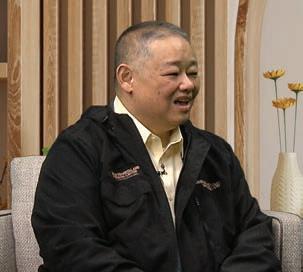
“We continue to maintain the high quality and standards of Asian Hospital because through this way, the world recognizes that we are really an international hospital,” added Dr. Tamesis.
For its part, Dr. Tamesis also revealed that the hospital is refreshing its training programs across departments to ensure the whole team is aligned with the goals of Asian Hospital. He said, “During the pandemic, we lost so many nurses because of the siren call abroad. So, this is just the right time to refresh the knowledge of our people to make aware again regarding all the standards necessary so that our patients are always safe in our hospital.”
Besides retraining and upskilling the Asian Hospital team, Dr. Tamesis said that they are also expanding their rehabilitation services, especially since there is high demand for it. According to him, the expansion took its cue from a 2024 report by the Department of Health that stated that the biggest causes of mortality and morbidity are cardiovascular diseases. “So, there is; from mobility to imrove to bring stroke patients, for instance, to be rehabilitated or improve their mobility—at least the daily activities of living. We have to make sure that we could really cater to this demand.”

The amiable Asian Hospital president said they are keeping their fingers crossed as they await the JCI results sometime between September to October. He continued, “With that, wish us luck. But we are confident about it.”
Learning Institute for training and development
KNOWN for hosting multi-disciplinary conferences, education and innovation are both part of Asian Hospital’s ongoing quest for quality standards, too. The top-class medical center has also established a Learning Institute to keep up with the changing needs of patients. In relation to the hospitals’ new services, Dr. Tamesis cited, “We’re hiring a lot of people— nurses, technicians, and doctors. So, we need to make sure that our standards for training and education are all the same. And at the same time, we’re able to tailor-fit particular programs for all the specific needs of patients.”
With former Chief Medical Officer, Dr Jose. Acuin at the helm of this unit, Dr. Tamesis added, “We are also making sure that our Articles of Incorporation fully embrace that we are a training center. So that the Philippine Regulatory Commission, our professional regulatory commission, could give us the accreditation that we need for continued professional development and training.”
Open to all professionals under Asian Hospital, the Learning Institute will also hopefully soon be accessible to trainees from other medical institutes, undergraduates in medical schools, interns, and medical clerks.
New hub for rehab services
THE third part of the “High Five Para sa 2025” campaign is the addition of a new building— an existing infrastructure, actually, within the location —that adds about 200 to 300 meters to the existing property.
“We managed to find this building that was basically ready for us. So, we said, okay, why don’t we put in our rehabilitation services there and then open new services, too, particularly the neuro-developmental services,” Dr. Tamesis said.
“Neurodevelopmental centers are important. Besides rehabilitation, we’re also talking about how there’s so much demand now for mental wellness, for gender services, so we’re toying with the idea of how we can further enhance the services we can offer in this space. And

with this new facility that we’ve managed to lockdown for the next five years, hopefully, we can mature these types of services that are in demand now.”
Other developments in the new building included the transfer of administration offices there and, soon, the creation of more training venues. This movement, said Dr. Tamesis, will free up the spaces from the main building and convert them back to patient rooms later.
Medical AI: State-of-the-art
Cyberknife
THE fourth exciting news is the acquisition of Robotics Enabled Radio therapy. This makes Asian Hospital the first in the country to use Cyberknife, which is robotics guided by artificial intelligence.
“Cyberknife can now deliver radiotherapy—intense radio therapy—for patients who need it now to handle their tumors. Even the metastatic lesions, yung kumalat na, mahahabol ng makinang ito,” explained Dr. Tamesis.
“It is very, very precise. You don’t need a large margin of safety, very tiny space lang ang mada-damage in terms of the tissue.. It’s very, very focused on the tumor or malignancy. It is painless with no cutting involved,” he said, “And hopefully, patients don’t need to go abroad anymore. It’s already here in the Philippines.”
Even better, Cyberknife also cuts down
radiation therapy from the normal 30-day span of sessions down to three to five days with 30-minute sessions each. Dr. Tamesis noted,
“Because of the intense delivery of radiation, it can really compress the duration of treatment. And depending on the location of the tumor, some malignancies only require one dose, one session.”
He said that there are many competent radiation oncologists who have already trained abroad with regards to using the machine. The arrival of Cyberknife at Asian Hospital will be a great opportunity for these specialists to practice their expertise.
Meet Ate Rose AND finally, as part of its commitment to public health awareness, Asian Hospital has also introduced Ate Rose, a dynamic female mascot wearing a very colorful housedress. People will readily see her greeting guests at the hallway or along corridors.
“We always think, what is the number one health problem of our people, our community, and the nation? Something that we’ve actually realized is that the number one killer is the leading cause of heart disease and stroke, which are just the final presentations.
Atherosclerosis is the underlying cause in all these,” Dr. Tamesis commented.
Atherosclerosis is a common disease that slowly develops when a sticky plaque consisting of cholesterol, fat, and other substances builds up in the arteries “You can
have familial, or congenitally, or inherited forms of that, but the vast majority is really one’s lifestyle: (unhealthy) diet, lack of exercise, smoking—these are the main drivers of atherosclerosis. And so we have to talk and educate our countrymen on what is atherosclerosis.”
Ate Rose, whose name was inspired from the first two syllables of the disease, is pretty much the visualization of the disease though she may seem friendly and unintimidating. It’s the light approach that, hopefully, can encourage people to address the deadly disease. To complement the awareness campaign, Asian Hospital has also launched the Ate Rose package for patients who want to undergo screening at affordable price points.
Editor: Jennifer A. Ng
B1 Monday, March 31, 2025
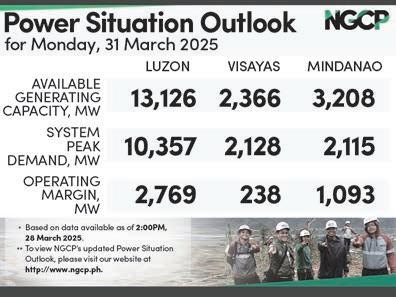

By VG Cabuag @villygc
AN executive of GT Capital Holdings Inc. said recently that the holding firm of the Ty family’s businesses is ready to spend between $100 million to $200 million for its diversification plans.
George Uy-Tioco Jr., the company’s CFO, said the company wants to lessen its dependence on the banking and automotive businesses, mainly from Metropolitan Bank and Trust Co. and Toyota Motor Philippines Corp.
“We’re in this situation now where we have strong performance of our business units and the next question is what do we do next [and] what sectors do we want to invest in next,” UyTioco said.
“What we’re trying to do now is we’re trying to finalize our investment plan and how we take GT Capital to the future....We’re on investment mode. We are in the process of looking for sectors and businesses that we can invest in to expand our portfolio,” he added.
Uy-Tioco said the company
is currently heavy on financial services and automotive, mainly because of the large size of Metrobank, the country’s third largest lender, and Toyota, which corners nearly half of the automotive market in the Philippines.
“So, what we’re looking for is to diversify and potentially look at something else that can help balance the portfolio so that in situations where financial services might not do as well, then you have something else to balance it. Any particular sector,” the GT Capital executive added.
While the company has not yet identified any specific investment target, Uy-Tioco said there are already active discussions in terms of potential opportunities, “and we just have to sift through all of them and decide which

makes sense.”
“I think it’s fair to say that we would look to invest as much as maybe, on a regular basis, we’d like to look at investing anywhere from $100 to $200 million,” he explained. “Our priority would be to take a look at managing our capex requirements as well as any capital required by our affiliates. And then, after that, whatever excess cash we have is available for investments or for other things.”
GT Capital is interest in investing in industries that are underpenetrated and very fragmented that will give the firm the the kind of returns that it wants, where it can make an impact, and that could contribute to the bottom line.
Among the sectors that the company is looking at are healthcare, renewable energy and data centers.
These sectors, according to UyTioco, are “very fragmented segments and the margins are very
good, there’s a need for it.”
The company, however, crossed out the possibility of venturing into the gaming industry or any sector that may be considered a vice.
“There is a morality aspect to it that we would prefer to avoid; it’s just not something that we would like to take a look at,” UyTioco said.
Affiliated or associated industries are going to be easier to invest in because GT Capital already has a specific knowledge in these industries and the company prefers to do this via acquisitions or partnerships although it is not ruling out greenfield investments.
“Partnerships is still the way to go. That’s always been in our DNA our preference is to work with partners. We we cannot say that we have the expertise in all the sectors that we want to get into and that’s where a partner becomes important,” Uy-Tioco said.
STATE-run firm Bases Conversion and Development Authority (BCDA), South Korean-led investment firm Hann Philippines Inc. (HPI) and its corporate social responsibility arm Hann Foundation Inc. (HFI) are set to establish a P5-million multi-purpose pavilion within the 10-hectare Ayta Ethno Botanical Center (AEBC) in New Clark City, Tarlac.
In a statement issued over the weekend, the BCDA said this “vital structure” inside the AEBC will be providing the local community with a venue for training, meetings, assemblies, exhibits, and other activities to protect and preserve Ayta culture and heritage.
On March 21, BCDA President and CEO Joshua M. Bingcang, HFI Executive Director Ana Christi G. Galura, and HPI Director of Corporate Finance Sheila M. Rivera signed a memorandum of agreement (MOA) for the construction of the pavilion.
“In New Clark City, our goal is to ensure that economic growth and development benefit all sectors of society, especially our local Aeta communities,” Bingcang was quoted in the statement as saying.
The BCDA president also noted that the state-run firm is committed to “empowering its stakehold -
ers” and building the AEBC into a “cornerstone” for agricultural education, innovation, and environmental stewardship.
Citing the AEBC as an example, Galura emphasized the importance of collective action of the government and private sector in making a “big impact” on the local communities.
“Everyone has a responsibility in nation building. Aside from promotion of cultural heritage, agriculture, and innovation, this project also promotes employment and entrepreneurship,” added the Hann Foundation Inc. Executive Director.
Through the knowledge and skills that will be gained in the halls of the AEBC, Galura said the Aeta and Capampangan communities will be “more future ready” to become eventual colleagues or even business partners at Hann.
According to the state-run firm, the 10-hectare AEBC, spearheaded by the BCDA in partnership with the Department of Agriculture (DA) Regional Field Office III and the Pampanga State Agricultural University (PSAU), aims to scale up the agricultural capabilities of local farmers and fisherfolk, especially the Aeta communities in Pampanga and Tarlac. Andrea San Juan

By Vincent Peter Rivera
BINGOPlus, the nation’s most comprehensive digital entertainment platform, marked its 3rd anniversary with its grandest celebration yet with BingoPlus Night 2025.
Filled with fun and entertainment, the gala night is a testament of the company’s achievements and contributions across the dynamic landscape of the country’s entertainment, its digital innovation, and its social impact on its players and the Filipino community.
Rafael Jasper Vicencio, President of AB Leisure Exponent Inc. and game provider of BingoPlus, reflected on the achievements of the past year and acknowledged the remarkable journey and growth of BingoPlus from its inception three years ago.
“It’s a mixed feeling because how I see it, the family is growing, from its first year now to the third year. The media, the cameras here alone, are really a testament how BingoPlus has grown,” Vicencio said.
At the same time, Vicencio expressed his gratitude to the BingoPlus employees, players, and winners for they are the ones who have made the company what it is today, contributing to the growing recognitions the platform has received.
“It is the people who have been
continuously supporting the brand because in my mind, ‘these things will not happen without them,’” he added, describing his #ProudMoment as the president of BingoPlus. Notably, BingoPlus and BingoPlus Color Game were nominated at the SIGMA Asia Awards 2024 for Best Casino Operator and Best Live Game Newcomer, respectively.
A joyful and jackpot evening AT the event, BingoPlus raffled off two cars, each valued at P2 million. It was also announced during the gala night that the jackpot prize had reached a massive P501 million, a significant jump from the previously stated P300 million. Adding to the event’s excitement was the gathering and special performances of local and international artists like Vice Ganda, Piolo Pascual, Angeline Quinto, Stephen Speaks, Parokya ni Edgar, and Miss Universe 2024 Victoria Kjær Theilvig.
Giving back to the community BEYOND the entertainment and
glamor, BingoPlus Night 2025 also served as an avenue for the organization to give back to the community. This commitment to the Filipino community is a core tenet of BingoPlus’s philosophy.
“The more we give back to the community, the more we give back to our players. I think that’s one of the reasons why BingoPlus continues to grow,” he said, highlighting the interconnectedness of BingoPlus to the Filipino community.
This commitment to community support was powerfully demonstrated during the event. Highlighting the BingoPlus Foundation’s 2024

Achievements, the organization also announced a substantial P150 million donation to further support its vital projects across four key pillars: Technology Education, Accessible Healthcare, Community Resilience, and Responsible Digitalization.
Fostering responsible players
STAYING true to its commitment to promote a responsible gaming environment, BingoPlus continuously reminded players of the importance of playing in moderation during its 3rd year anniversary.
“Don’t spend money you do not have yet,” said Nicole Cordovez, Miss

Grand International 2016 1st Runner-
Up and one of the event hosts.
“And never hide it from your friends and parents, so it doesn’t become an addiction in itself” she continued.
“[They will serve] as your mirrors or people who can monitor you.”
As the official ambassador of BingoPlus, Pascual reiterated the importance of playing responsibly.
“The bottom line is if you work hard for the money, you don’t want to risk it, you want to play responsibly, and this tests your discipline,” he explained.
He added: “If you know your limit, then that’s it, stay there.



Because if you go over and spend beyond your limits, then you’re going to be in trouble.”
Despite numerous breakthroughs in its first three years, Vicencio promised the BingoPlus community that there is still a lot to look forward.
“What BingoPlus can really promise is it will continue to innovate since the goal of the brand is to improve and expand. Of course, we will give emphasis to the BingoPlus Foundation. Every year we will increase the amount [of donation] so that more Filipinos will be touched,” Vicencio concluded.



Editor: Jennifer A. Ng

By Lorenz S. Marasigan @lorenzmarasigan
PAL Holdings Inc., the parent company of Philippine Airlines, saw its net income crash to P8.11 billion in 2024, a 62-percent drop from the P21.78 billion the previous year, as it continues to struggle with soaring expenses and mounting financial charges.

In a regulatory filing, the company said its revenues declined slightly to P178.01 billion from P179.12 billion, as its passenger revenues sank to P154.95 billion from P159.58 billion.
Cargo, ancillary, and other revenues, however, posted slight increases to end at P9.16 billion, P13.82 billion, P81 million.
In contrast, the company posted a six-percent increase in expenses to P160.04 billion from P151.04 billion the year prior, as flying operations, maintenance, aircraft servicing, passenger servicing, and reservations expenses rose. It also posted P7.02 billion in financing charges and other charges. PAL’s financial performance in 2024 was also a sharp contrast to 2022, when the airline posted P10.36 billion in net income following its successful restructuring program.
“PAL’s financial discipline is critical in a very cyclical industry. Enabled by the gains we have made postrestructuring, we are making purposeful investments to improve our product and update our systems with the aim of delivering better service to our passengers more efficiently,” PAL CFO Anna Bengzon said. In 2024, PAL flew 15.6 million passengers, marking a six-percent rise from 2023, and operated 110,867 flights across its network, a five-percent increase from the 105,294 flights the year prior.
SHARE prices fell for the third straight week as the main index dipped below its 50day exponential moving average, which were pulled back by interest rate-related chatter. The benchmark Philippine Stock Exchange (PSE) index fell 119.31 points to close at 6,147.44 points.
The main index was mostly down during the week, with small gains in between down periods.
“Trading has been anemic showing weak market confidence,” said Philstocks Financials Inc. Senior Research Analyst Japhet Louis O. Tantiangco. Average trading for the week only reached P4.02 billion, with foreign investors, who cornered 48 percent of the trades, were net sellers at P1.96
For the week, losers outnumbered gainers 156 to 67 and 27 shares were unchanged.
The top gainers were Manila Mining Corp. A and B shares, GEOGRACE Resources Philippines Inc., Omico Corp., Grand Plaza Hotel Corp., Central Azucarera de Tarlac Inc., LFM
and Equities Corp. A.
THIS WEEK
SHARE prices may continue to trade downward this week, with profit-taking seen occurring in between.
It will be a four-day trading week as April 1 was declared a regular holiday throughout the country in observance of Eid’l Fitr (Feast of Ramadan).
Tantiangco said trading will still see global economic outlook concerns— caused by the US protectionist stance—posing downside risks to the local bourse.
“In line with this, investors are expected to watch out for the implementation of the US upcoming reciprocal tariffs to see if there will be any adjustments. Any new tariff announcement from the US government is expected to pull the local bourse lower,” Tantiangco said.
“On a positive note, hopes that the BSP [Bangko Sentral ng Pilipinas] will cut rates in their April meeting may help lift sentiment. In connection to this, investors are expected to watch out for our March inflation due on Friday as this will give clues on the BSP’s next policy moves,” he added.
Broker 2TradeAsia said sentiment remains relatively fragile above 6,300 as upcoming inflation data and central bank policy rhetoric remain at the forefront, ahead of any mid-year adjustments at the corporate earnings level.
“We reiterate that rate cuts for the most part are a second-half story, but improving liquidity conditions should help guide near-term price action; lookout for stabilized global appetite and foreign inflows that may be required for the PSEi to break out of its current tight range,” it said.
Immediate support is seen at 6,000 points, resistance is at 6,400 points.
BROKER Regina Capital Development Corp. (RCDC) gave a trade the range advise on JG Summit Holdings Inc. (PSE: JGS) as its share price recovered after a series of declines, but remains capped below its long-term moving average.
“The 50-day MA continues to act as its resistance. Meanwhile, MACD reflects a softening of bearish momentum, while RSI ticks up to 43.69. On the trend front, DMI shows that sellers are still in control, albeit losing grip, while ADX signals weak trend strength. Given these indicators, traders may look to trading within the range,” RCDC said. JGS’s closed last week at P16.48 apiece. Meanwhile, the broker gave the same advise on the stock of Monde Nissin Corp. after the price of its stock (Monde) declined failing to sustain its recent recovery and trading near its support.


“MACD reflects a loss of bullish momentum, while RSI at 41.51 suggests weak buying pressure. The DMI [directional movement index] shows sellers still holding the advantage, though ADX [average directional index] indicates a lack of strong trend direction. Given these indicators, traders may opt to trade the range,” RCDC said. Monde was last traded at P7 apiece. VG Cabuag
AS US stock prices tumbled
this month, John Sidawi, a fund manager at Federated Hermes, noticed something strange.
The dollar, long a go-to hiding place during market selloffs, wasn’t rallying this time as investors rushed for safety. It was sinking, too, and fast as hot money poured into gold, the yen, European stocks—almost anywhere but the US.
“It’s unusual and very telling,” said Sidawi, who helps oversee bond investments at the firm. “The dollar, in an environment where it should be acting like a safe haven, is not.”
That, as with so much of the volatility that has whipsawed global markets recently, has a singular explanation: President Donald Trump.
Just two months into his second term, his escalating tariffs and bid to roll back decades of globalization is shaking confidence in the US currency—which has had a privileged place at the heart of the world financial system for eight decades.
The dollar has dropped against all but a handful of the 31 major currencies over the last three months, sending Bloomberg’s dollar index down nearly 3 percent, its worst start to a year since 2017. The price of gold— a rival haven—has surged to a record high of over $3,000 an ounce. By mid-March, speculative traders started betting against the dollar for the first time since Trump’s election amid fear his policy shifts could drive the world’s largest economy into a recession.
“As opposed to being the usual bastion of stability and first choice haven for foreign-exchange market operators, the greenback instead now stands as quite the opposite,” said Michael Brown, a senior research strategist in London for Pepperstone, one of the largest currency brokerages. He said an increasing number of clients are asking “where should I be looking at as opposed to just switching on the autopilot and hiding in the dollar?”
The recent drop hasn’t significantly eroded the strength of the dollar, given how much it had previously risen on the back of the nation’s strong economy and elevated interest rates, and it could bounce back if worries about a global slowdown cause overseas investors to pile into US Treasuries. It also remains solidly entrenched as the world’s key currency, used for the majority of central bank reserves and for the purchase of commodities like oil, in large part because no significant alternative has emerged.
“The rise and fall of currencies is not something that occurs because you get a wildcard president that is doing his best to kill globalization,” said Carmen Reinhart, a Harvard University professor and former World Bank chief economist. “The dollar did not overtake the British pound as a reserve currency overnight.”
But Trump’s actions are rekindling long-simmering discussions about whether overseas governments will accelerate efforts to lessen reliance on the dollar. In Europe, leaders have seen it as an opportu-
nity to strengthen the euro’s role by creating more integrated, liquid markets that would allow the common currency to better rival the dollar. In the developing world, a handful of countries have also periodically floated the idea of banding together to challenge the dollar’s supremacy.
Trump has said he wants to maintain the dollar’s central role globally, once threatening to retaliate against any country that tries to decouple its trade from the US currency. At the same time, during his campaign he indicated he’d welcome a weaker dollar because it would make US products more competitive. That’s spurred speculation that he could be using his trade war to strong-arm governments into cutting a grand bargain that would do just that, though the White House hasn’t publicly floated any such plans. Yet those goals—of either maintaining the dollar’s standing, or persuading other governments to act in the interest of the US—seem out of sync with Trump’s isolationist agenda and approach that has alienated allies.
In a note to clients Thursday, Jane Foley, a strategist in London for Rabobank, said Trump’s trade policies, pullback from military alliances, and casual talk of taking over Canada or Greenland “could accelerate the trend to de-dollarise and undermine the value” of the US currency.
At Deutsche Bank AG, George Saravelos, the global head of FX strategy, warned clients this month that the chance of the dollar losing its safehaven status as markets adjust to a new geopolitical order “needs to be acknowledged as a possibility.”
In financial markets, such longterm considerations are taking a back seat to more immediate repercussions.
US stocks slid again this week, with the S&P 500 Index falling another 2 percent Friday, after he slapped tariffs on imported cars. Traders are now hanging on his plans to announce what may be his biggest ones yet—a slate of broad increases—on April 2, which he has taken to calling “Liberation Day,” based on his belief that raising barriers to imports will create jobs as companies produce more domestically.
In theory, tariff increases should strengthen the currency by reducing demand for imports and bolstering domestic factory output. But it has depreciated instead because the scale of Trump’s hikes risks both reigniting inflation and slowing growth.
Administration officials have downplayed such worries, saying there may be temporary side effects from a program—which includes slashing government payrolls and cutting spending—that will eventually rejuvenate the economy.
Still, that short-term pain is what’s worrying Wall Street. After staging one the strongest two-year advances since the dot-com bubble of the 1990s, the S&P 500 Index has slumped 9 percent since mid-February, weighed down by concerns about the economy and the heady valuation of tech stocks after the artificial-intelligence boom. Bloomberg News

ABy Reine Juvierre Alberto @reine_alberto
S banks face tighter financial conditions and non-bank financial institutions (NBFIs) expand, concerns over heightened leverage, riskier asset exposure and increasing non-performing loans (NPLs) were flagged by regulators.
In the 2024 Financial Stability Report (FSR), inter-agency Financial Stability Coordination Council (FSCC) said global uncertainties and tight financial conditions affect bank lending to certain industries.
While strong loan growth in real estate, wholesale and retail trade and manufacturing are observed, these industries are also top contributors to NPLs.
These sectors are also likely to be affected by offshore shocks such as oil price swings exacerbated by geopolitical tensions, supply chain disruptions and interest rate volatility.
The Philippine banking industry’s gross NPL ratio settled to 3.38 percent, amounting to P512.828 billion in January 2025. This slightly increased from 3.27 percent in December last year.
Particularly, real estate loan exposures must also be closely monitored due to evolving market conditions.
“The high-interest rate environment, shifting consumer preferences, remote work arrangements and recent government pronouncements banning Philippine Offshore Gaming Operators have implications on the sector’s loan quality,” the report read.
Despite potential risks, the FSR noted that banks appear “well-positioned” to absorb expected credit losses.
The financial system has regulatory frameworks and other risk management tools in place to mitigate concentration risks and improve resilience against risks, it added.
Meanwhile, the report also flagged the growth of NBFIs, which could bring in potential risks, such as interconnectedness with banks and exposure to the broader market ecosystem.
“NBFIs’ expansion in lending activities against the highly regulated banking sector increased leverage in the financial system,” the report said.
Moreover, the prolonged highinterest rate environment affects credit as an asset class, leading to a rise in NPLs.
Loans from insurance companies and government pension funds grew by 6.2 percent and 1.2 percent year-on-year, respectively, while NBFIs supervised by the Bangko Sentral ng Pilipinas (BSP) with trust authority saw a 65.1 percent increase in loans.
“The quality of these exposures
must be monitored given the increasing NPL ratio in the banking system, particularly on household loans and certain segments of production sectors, to which these NBFIs may be similarly exposed,” the report said. While common exposures are also relatively low, in terms of amount, between banks and NBFIs, the report said these are possible sources of price and valuation risks.
“A decrease in the market value of these assets can spill over to the banking system. Changes in market value also impact other investors,” it added.
Further, the expected global transition to a more accommodative monetary policy environment may affect insurers and pension funds. Low interest rates are said to impact re-investment returns of pension funds and insurance companies’ fixed-income portfolios, as well as to seek higher yields from riskier investments.
“With increased interdependence between banks and non-banks, systematic monitoring and assessment of these interlinkages necessitates the closure of existing data gaps,” the report noted.

By Ma. Stella F. Arnaldo @akosistellaBM
Special to the BusinessMirror
OVER P17 billion in travel taxes have been turned over to the Commission on Higher Education (CHED) since 2010 to help enhance tourism education in the country.
This was disclosed by the Tourism Infrastructure and Enterprise Zone Authority (Tieza) at a recent signing with the Department of Tourism (DOT) and the CHED of a Joint Administrative Order (JAO) that establishes guidelines to ensure provisions of the laws on higher education and tourism education funding are efficiently and properly executed.
Speaking on behalf of Tieza Chief Operating Officer Mark T. Lapid, Assistant COO Karen Mae SarinasBaydo said: “Our combined efforts will ensure that every peso from the travel tax goes to funding innovative programs, while creating industry-immersion opportunities and capacity-building initiatives to develop future tourism professionals and leaders. So, by prioritizing tourism education, we are investing in our nation’s most valuable asset, its people, and setting a solid foundation for the sustainable growth and the future of Philippine tourism.”
The signing of the JAO will also help guarantee the transparency in the utilization of the Higher Education Development Fund (HEDF), which was established under Republic Act (RA) 7722 (Higher Education Act of 1994). The HEDF is an autonomous buffer fund to support CHED’s fiscal independence, and comes from

40 percent of the Tieza’s gross travel tax collections, 30 percent of collected professional regulation fees, and one percent of gross sales of lotto operations by the Philippine Charity Sweepstakes Office.
The CHED is mandated to prioritize tourism-related educational programs and courses under RA 9593 (Tourism Act of 2009) for the amounts turned over by Tieza. The DOT failed to provide any information on CHED’s tourism education projects, nor data on students enrolled or have graduated from tourism or hospitalitymanagement degrees. Separately, according to the Find University web site, there are 418 colleges or universities that offer tourism or hospitality management as undergraduate degrees in the country.
Last year, Tieza collected P7.75
CONSUMER spending was weaker than expected again in February while a key inflation metric picked up, in a double whammy for the US economy before the brunt of tariffs. Markets and world leaders are all bracing for next week, when President Donald Trump has planned a rollout of tariffs dubbed “Liberation Day” on April 2. He’s already imposed some levies on Canada, whose economic growth came to a halt in February after a solid start to the year.
US and Canada
INFLATION-adjusted consumer spending edged up 0.1 percent, on the low end of economists’ estimates, after a slump January that analysts mostly blamed on bad weather. The so-called core personal consumption expenditures price index, which excludes food and energy items, was up 2.8 percent from last year, remaining
stubbornly above the Federal Reserve’s 2 percent target. Trump appeared to invent a new weapon of economic statecraft on Monday by threatening what he dubbed “secondary tariffs” on countries that buy oil from Venezuela to choke off its oil trade with other nations. The novel approach adds to a growing list of weapons that Trump has been eager to deploy as part of a push to use America’s economic clout as leverage in achieving its foreign and domestic policy goals. The stock market volatility set off by concerns over Trump’s rapidly shifting trade war threatens one of the primary growth engines of the US economy: spending by high-income earners. Trump’s administration has already imposed tariffs on some products the US buys from Canada, and further levies expected in coming weeks—if sustained—
will likely plunge the economy into recession. With Canada’s retaliatory tariffs raising prices for imports, there’s risk that inflation may rise above the bank’s upper target range of 3 percent.
Europe
UK retail sales have risen strongly since the start of 2025 in a sign that households are beginning to spend the pot of savings they built up last year. Sales of household goods climbing almost 7 percent, the largest increase since April 2021. Jewelery, watches and clothes also saw a bounceback in demand. German business optimism rose to the highest level since June 2024 as Chancellor-in-waiting Friedrich Merz readies hundreds of billions of euros of spending to
the government some breathing room as it struggles to lower its debt load.
Asia INDIA is reviewing US demands it cut import duties on farm goods and significantly reduce other barriers, people familiar with the matter said, as officials in New Delhi press for an exemption from Trump’s re
ciprocal tariffs next week. Australia’s center-left government unveiled an unexpected tax cut and an extension of energy rebates in a
billion in travel taxes, up 7.6 percent from 2023. Of the total, P3.1 billion went to CHED. Tieza travel taxes also help support the National Commission for Culture and the Arts (10 percent), but retains 50 percent of its collections for its operating budget. (See, “Govt bags P7.75B in taxes as outbound travel surges,” in the BusinessMirror , February 17, 2025) At the event, Tourism Secretary Christina Garcia Frasco said: “It is our sincere hope that by way of instituting, clear, fair, as well as stakeholderdriven programs under the JAO, the funds that our fellow Filipinos pay in travel taxes are devoted in full to education programs that will further expand opportunities for young people to join the tourism industry and expand economic opportunities
from our local destinations, who will inevitably benefit from a tourism workforce that is well educated, well capacitated and world-class in terms of skills.”
The JAO outlines provided CHED the priority areas for funding. These include: the construction, or improvement of facilities and/or demonstration labs for tourism and hospitalityrelated courses including the purchase of industry-grade equipment to support the facility; an industry immersion program and career development for teachers and students; technology innovations or digitalization in tourism and hospitality programs; start-up/incubation centers on tourism and hospitality; research and development for enhancement of tourism-related programs and courses; and tourism education-related programs and education tourism programs to be implemented in partnership with the DOT and Higher Education Institutions. For his part, CHED Chairman J. Prospero E. De Vera III noted that with the guidelines, “we can continue to produce graduates that match the standards and demands of the tourism and hospitality industry here and all over the world.” The funds “will also be able to provide more grants for research and development for the enhancement of tourism-related programs and courses. We can send more faculty members to top tourism universities and institutions abroad for upskilling and reskilling programs as instructed by the President so that our faculty members are addressed and upskilled as far as tourism promotion is concerned,” De Vera added.
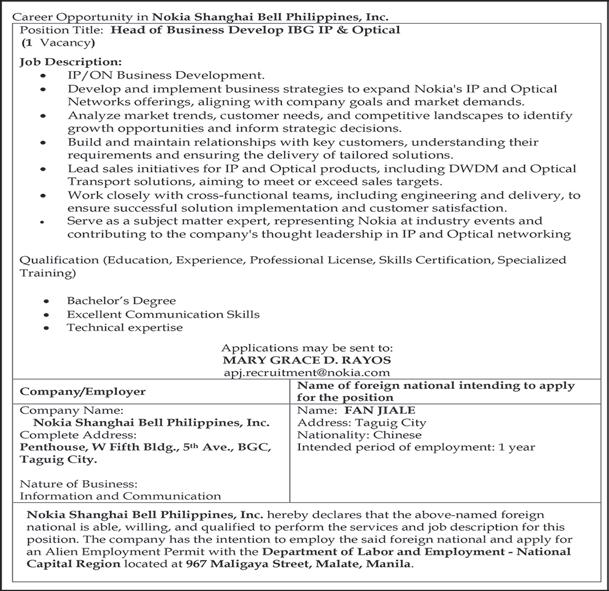

By Alexa St. John & Paul Wiseman The Associated Press
DETROIT—President Donald
Trump’s 25% tax on imported cars, light trucks and auto parts is likely to drive up prices at a time when many Americans already struggle to afford a new set of wheels. The tariffs will also force car companies to rethink what cars they make and where they make them.
Trump has been itching to tax foreign autos for years. In his first term, he declared auto imports a threat to national security, which gave him the authority to impose tariffs on them. On Wednesday, he went ahead and imposed the levies. They take effect midnight April 3. It’s the latest in a number of auto industry maneuvers by Trump during his first weeks back in the White House. Auto companies are also navigating the reversal of fuel economy standards, dialed down greenhouse gas emission standards and a host of electric vehicle policy rollbacks. Some of the details of Trump’s auto tariffs have yet to be worked out. For example, it’s unclear whether the new auto tariffs would
next
on
goods from Canada and Mexico.
That would mean cars from Canada and Mexico could potentially face new tariffs of 50 percent. And for now, the Trump administration is exempting from the t ariffs cars, light trucks and auto parts that qualify for duty-free treatment under the US-MexicoCanada Agreement, a regional trade pact the president negotiated five years ago. Trump intends t o narrow that exemption to content made in the United States, n ot Canada or Mexico. But that will require setting up processes to determine what qualifies as USmade something that could take weeks or months.
The White House also said the import tax would apply to “key’’ auto parts, including engines, transmissions, powertrain parts and electrical components. And it could expand the tariffs to other auto parts “if necessary.’’
Here’s what else to know:
Why are tariffs so challenging for the auto industry?
AS automakers expanded globally, they created complicated and efficient supply chains that spanned c ountries. In North America, for instance, Mexico supplies lowwage labor and makes smaller, less expensive cars and trucks while Canada and the United States provide more skilled labor and technological know-how.
Trump’s tariffs are intended to bring auto manufacturing back to the United States. But it won’t be easy.
Rerouting the sourcing of thousands of parts that are imported t o the US and uprooting assembly operations would take years.
“It adds to the uncertainty facing all automakers as the industry’s s upply chain is inherently global and has optimized around moving components across national borders where free trade agreements h ave existed in the past,” said John Paul MacDuffie, professor of management at the University of Pennsylvania.
Sam Fiorani, analyst at AutoForecast Solutions, notes that w hile European makers of luxury vehicles and their buyers can afford some price adjustments, “it’s t he companies like Toyota, Mazda, and Subaru who import large percentages of their fleets that will t ake a beating.”
“Throwing tariffs on the parts of vehicles built in Mexico and Canada that aren’t sourced from the U nited States will hurt the profits of General Motors, Stellantis, and Ford over the next few quarters,
costing them billions,” he added. Trump’s tariffs—which he insists are permanent—will force c ompanies to make hard choices.
“It’s going to have the effect of forcing companies to increase US content’’ if they want to dodge the import taxes, said Richard Mojica, a trade attorney with Miller & Chevalier.
And even though Vanessa Miller, chair of the automotive team at t he law firm Foley & Lardner, acknowledges that some companies w ill be able to pivot operations to the US, others are too tied to factories in Mexico or elsewhere to m ake the move anytime soon.
Automakers might have to stop making some vehicles because they won’t be profitable with the tariffs in place. The tariffs hit “everyone in a manner that makes them r ethink everything,’’ said Ivan Drury of the automotive website Edmunds. “This is around at least three or four years. We’re not looking at something you can just ride o ut.’’
What does this mean for car buyers and new car prices?
BEATA CARANCI and Andrew Foran of TD Economics estimate that t he tariffs could raise the average price of cars and light trucks in the United States—which totaled more than $47,000 last month— by up to $5,000 if automakers pass along the entire cost to consumers. That price hike could go h igher—to as much as $10,000— if the Trump administration applies the tax fully to cars made in M exico and Canada.
Automakers and their suppliers are only now recovering from
y ears of instability brought on by pandemic-forced production halts, a sweeping semiconductor shortage and low inventory on dealership lots. That meant prices were s ky-high, incentives were low and few deals were to be had.
During the peak of the pandemic, consumers still bought vehicles a t high prices. But the piled-on tariffs could put new vehicles out of r each for many would-be buyers, especially given rising indications of potentially broader inflation ahead throughout the economy.
“Starting almost immediately, consumers will see their already expensive new vehicles cost hundreds to thousands more and those p rices will escalate even more when the supplies of many key vehicles dwindle,” Fiorani said. “Imagine the price rises during the semiconductor shortage and stretch it o ut across every brand and manufacturer. The trickle-down effect w ill put smaller suppliers out of business and send many workers onto unemployment.”
What about used cars?
BY raising new vehicle prices, tariffs will likely send buyers to the u sed market. But with limited used inventory, an influx of buyers could rock used car prices, too. And they already average $25,000.
Lease penetration, or the number of vehicle transactions that a re leases, has averaged around 30 percent or so over the past 10 years, according to Edmunds data.
But the industry saw low rates of leasing—nearly half the norm— particularly between May 2022 and January 2023. Fewer leased vehicles typically means fewer two- or
t
hree-year-old vehicles being put on the used-car market. So there is likely to be a shortage of used cars just as more buyers s tart shopping for them.
How has the industry responded?
GOVERNOR Matt Blunt, president of the American Automotive Policy Council, which represents US automakers, said that manufacturers s upported Trump’s efforts to boost domestic auto manufacturing. But he cautioned that “it is critical that tariffs are implemented i n a way that avoids raising prices for consumers and that preserves the competitiveness of the integrated North American automotive sector.
T he United Auto Workers labor union applauded the tariffs. “Ending the race to the bottom in the a uto industry starts with fixing our broken trade deals, and the Trump administration has made history with today’s actions,” UAW President Shawn Fain said in a statement. “These tariffs are a major step in the right direction for a utoworkers and blue-collar communities across the country, and i t is now on the automakers, from the Big Three to Volkswagen and beyond, to bring back good union jobs to the US.” But Jennifer Safavian, president and CEO of Autos Drive America, which represents international auto manufacturers, denounced the tariffs: “The tariffs imposed today will make it more expensive to p roduce and sell cars in the United States, ultimately leading to higher prices, fewer options for consumers, and fewer manufacturing jobs i n the US.”

LINGAYEN, Pangasinan—The northern province not only boasts of a bountiful supply of bangus (milkfish), bocayo (coconut caramel/ toffee), and bagoong (fish sauce/paste), but also an abundance of beautiful women.
A parade of pretty Pangasinenses were introduced on March 16 at the Sison Auditorium to a select group of national media during the launch of Limgas na Pangasinan 2025, the biggest and most prestigious beauty pageant in the province, to determine who among them will be the Darling of the Press and Miss Photogenic.
The “Limgas na Pangasinan” (Beauty of Pangasinan), which was originally called “Limgas na Dayat” (Beauty of the Sea), preliminary competition will be held on April 13, while the much-awaited Grand Coronation Night will be on April 25.
The press presentation was the official start of the quest that will select Pangasinan’s representatives to Miss World Philippines, Mutya ng Pilipinas and Miss Grand Philippines. Out of a possible 48 candidates (comprising four cities—Dagupan, Alaminos, Urdaneta, and San Carlos—and 44 municipalities), 21 witty and awesome women will be vying for the three titles.
The candidates are: 1. Reign Joy C. Lim (Bayambang); 2. Kayzee Chasta P. Brillo (Umingan); 3. Leinahtan L. Sarmiento (San Carlos City); 4. Kyla S. De Leon (Basista); 5. Xyza Nicole S. Aguilar (Mangaldan); 6. Louise Anne A. Vergara (San Manuel); 7. Cheska T. Donato (Bugallon); 8. Grace Jineah C. Lumague (Pozorrubio); 9. Clarisse C. Borbe (Alcala); 10. Liannah Jermayne L. Mangosong (Asingan); 11. Felicity C. Mamplata (Lingayen); 12. Krysha R. Villanues (Binalonan); 13. Marianne Jinnah F. Nandin (Balungao); 14. Chelsea Mae M. Oranza (Malasiqui); 15. Alannis Sophia Melarne F. Hiidge (Sual); 16. Ma Julianne Vernice F. Nandin (Rosales); 17. Venus B. Sawaysaway (Dasol); 18. Freda V. Rosario (Labrador); 19. Angelica Joy B. Flores (Sta. Barbara); 20. Claire Arwen V. Cacal (Calasiao); 21. Rosemarie O. Ernang. Vice Gov. Mark Ronald DG. Lambino, who was joined by his wife, Atty. Melanie Lambino, delivered the welcome message. Also in attendance was Provincial Tourism and Cultural Affairs Office head Malu Elduayan.
The pageant’s executive chairperson, Pangasinan First Lady Maan Tuazon-Guico, gave an inspiring message for the candidates. Here are excerpts:
“We have had the privilege to witness and grace the grace, intelligence, beauty of 21 remarkable candidates from all over Pangasinan.
“Each candidate has shown us that beauty is not merely skin deep. It is a reflection and reflected in


LIMGAS na Pangasinan candidates (clockwise): 1. Reign Joy C. Lim (Bayambang); 2. Kayzee Chasta P. Brillo (Umingan); 3. Leinahtan L. Sarmiento (San Carlos City); 4. Kyla S. De Leon (Basista); 5. Xyza Nicole S. Aguilar (Mangaldan); 6. Louise Anne A. Vergara (San Manuel); 8. Grace Jineah C. Lumague (Pozorrubio); 9. Clarisse C. Borbe (Alcala); 10. Liannah Jermayne L. Mangosong (Asingan); 11. Felicity C. Mamplata (Lingayen); 12. Krysha R. Villanues (Binalonan); 13. Marianne Jinnah F. Nandin (Balungao); 14. Chelsea Mae M. Oranza (Malasiqui); 15. Alannis Sophia Melarne F. Hiidge (Sual); 16. Ma Julianne Vernice F. Nandin (Rosales); 17. Venus B. Sawaysaway (Dasol); 18. Freda V. Rosario (Labrador); 19. Angelica Joy B. Flores (Sta. Barbara); 20. Claire Arwen V. Cacal (Calasiao); 21. Rosemarie O. Ernang; and 7. Cheska T. Donato (Bugallon) PHOTOGRAPHED BY BRYAN MAMAWAN; OUTFITS BY GLENN GONZALES AND GLENNZIE TAGUIANG AQUINO
their voice, their commitment in their communities, their aspiration for a brighter future. They remind us that the true beauty of Pangasinan lies within its people.
“We have continued to provide Pangasinan women with the opportunities to empower themselves in the government units and in our province. In fact, our winners are official representatives to various
family. Personally, I am so grateful and honored to be part of a brand that is youthful and also for empowered women. They take good care of their families, and I grew up with a mom like that. Women empowerment has never been this beautiful,” said Kaila during her introduction to the media as Barefaced’s new face. “No matter what business you want to do, do it, and people will support you. We are far from our actual dreams, but we have already come so far. We try our best to continue to release quality products and address the concerns of Filipinos and the international market. We hope you love it as much as we do,” said Roma. The owners said they chose Kaila to be Barefaced’s ambassador because of her effortless beauty and authenticity, which perfectly represent the brand. “She’s very flexible to what our brand wants to say to the people who are using it. Very simple, straightforward but very powerful,” they said.
HAIR COLOR AS A MEANS OF SELF-EXPRESSION
Sunkissed Tinted Light Sunscreen and Barefaced Melt Away Facial Cleanser. Sunkissed Tinted Light Sunscreen is a lightweight, multi-functional sunscreen that protects the skin against harmful UV rays but also provides a naturallooking and very blendable tint, while the Melt Away Facial Cleanser gently and effectively dissolves makeup, sunscreen and impurities.
“I always believed that I am not traditionally beautiful so I am happy to be part of the Barefaced
MIN ROLDAN, creative director at DDB Philippines, believes in embracing vulnerability and courage as part of her journey. By creating spaces where women feel seen and valued, she’s helping them discover strengths they never knew they had. For Roldan, loving her natural hair and experimenting with color were essential in her journey. Beauty standards dictated what her hair “should” look like and that’s long, straight and easy to manage. “It wasn’t just about hair anymore—it was
national projects showcasing the talent and pride of Pangasinan on a larger scale. Particularly, our Limgas Na Pangasinan World 2023 Miss Nikki Buenafe will be our country’s representative to the prestigious Miss Multinational...
“To our lovely candidates, to our Limgas Na Pangasinan 2025 candidates, you have all made us proud. To us, you are already winners, and I am sure
to each and every town you represent, you are their pride and you have represented them well. Your journey does not end here. It is only the beginning, and I hope and pray that everything you learn from us, from your time with us, from the trainings to our consultations, and even to the pageant, the moral lessons that you learned, the character building, I hope that you bring it with you not only in your future endeavors in the pageant industry, but throughout your life...
“I hope that everyone in Pangasinan appreciates what we have done so far, and that we truly represent Pangasinan, its culture, its arts, and its heritage. This cause of empowering women is very close to our hearts, and we will always support initiatives that uplift and celebrate the beauty and strength of Pangasinan women.”

A BURST OF COLOR WITH A BOOST OF MOISTURE
WHEN it comes to the perfect lipstick, why choose between color and hydration when you can have both? Introducing the EB Plus Moisture Boost Lipstick—a lightweight, pigment-packed lippie infused with Hydracore Technology to keep your lips beautifully colored, nourished, and moisturized all day long.
Unlike traditional lipsticks that can feel drying over time, EB Plus Moisture Boost Lipstick is designed to deliver an instant hydration boost with every swipe. It features Hydracore Technology, a unique formula with a hydrating balm at the center of the lipstick bullet. This ensures that as you apply your lipstick, your lips stay moisturized, soft, and plump—without compromising on rich, long-lasting color.
This ultra-lightweight formula is packed with skinloving ingredients, offering a comfortable, nourishing wear that leaves a long-lasting stain. No more sacrificing lip health for bold color.
The EB Plus Moisture Boost Lipstick collection comes in nine stunning shades, perfect for any look: Misty Mauve (rosy mauve whip), Toast of New York (classic brick red), Dewy Rose (lovely candy pink), Watermelon Drop (punchy neutral punch), Raspberry Pop (chill berry hue), Maple Syrup (vintage warm brown), Wine Red (rich neutral burgundy), Cool Cocoa (soft choco brown) and Juicy Tomato (fresh peachy red).
The EB Plus Moisture Boost Lipstick (P295) is available in all Watsons, SM Beauty Department Stores, Robinsons Department Stores, and all leading department stores nationwide.

but a statement of self-acceptance and authenticity as she believes confidence isn’t about perfection but about showing up as your true self and giving others permission to do the same. Roldan’s collaboration with Cynos became a means for self-expression. By experimenting with colors and styles, she gets to show her playful and adventurous side. Cynos Salon Professional Color System has advanced conditioning agents and nourishing oils so women can wear vibrant, long-lasting colors without compromising hair health.
“Women should take up more space and
Salons now have the opportunity to offer not just a
Monday, March 31, 2025
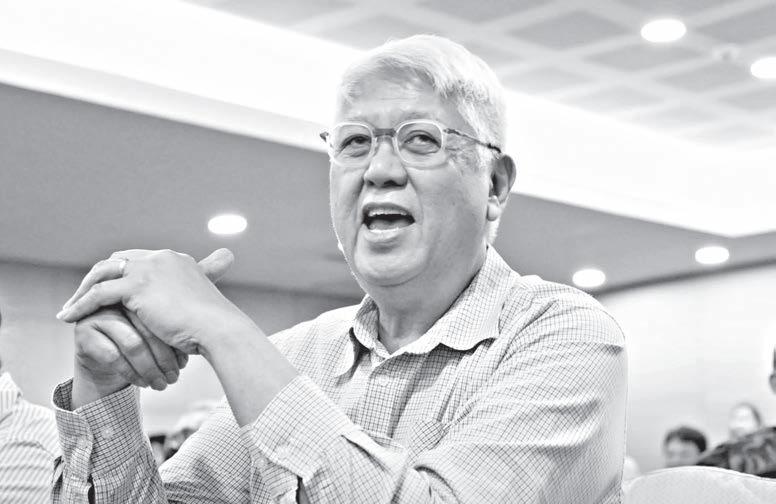

IATTENDED the launch of a “fake book” two weeks ago. The first time I heard the term “fake book,” I thought it meant those counterfeit book reprints being sold on e-commerce platforms. But apparently, in music, fake books are a compilation of sheet music that anyone who can read notes and play an instrument can play and enjoy.
Trina Belamide, a multi-talented musician and someone whose music I have admired for decades, launched her own fake book titled Trilogy (Trina’s Anthology), which contains 30 songs that she described as “the most important or impactful ones out of the more than 200 that I’ve composed as a professional songwriter.”
The book is divided into three categories, in keeping with the trilogy theme: ballads, love songs, and wedding favorites; gospel, inspirational, and kidfriendly songs; and TV, film, contests, and special themes. Each of the 30 songs not only has its sheet music, but also has accompanying stories told in Trina’s own words.
The copy was written in Taglish, a direction that book

n SLGS PHILIPPINES CHAMPIONS WOMEN IN TECH WITH EMPOWERING IT WORKSHOP
MANILA, PHILIPPINES—In celebration of Women’s Month, Sun Life Global Solutions (SLGS) Philippines, the Global Capability Centre of insurance and asset management leader Sun Life, took a bold step toward shaping the future of women in technology. Through IT Girls: Empowering the Youth in their IT Careers, SLGS Philippines ignited passion and ambition among young women
aspiring to break into the world of tech.
Designed to inspire, equip, and propel women into successful careers in IT, the workshop provided an immersive experience by offering industry insights, career pathways, and hands-on learning opportunities with industry leaders from SLGS Philippines.
SLGS Philippines, in collaboration with WiTech (Women in Technology), a non-profit advocating for gender inclusivity in tech, welcomed students from various universities to an afternoon of insightful discussions and engaging activities.
“SLGS is a strong believer of the importance of nurturing an inclusive and respectable environment. As the technology solutions provider to the lead -
editor Tina Arceo-Dumlao decided to go with when the book was still being conceptualized. During the launch, Trina related that when she asked Tina how she should write the book, the seasoned news editor and book author said to just let her thoughts flow and write as she spoke. So that was what they did. And her editor said that they were going to keep that style, that language. The Taglish approach works. For people who know Trina personally, you will surely hear her voice in your head as you read each chapter, each line in the book. It is like sharing a cup of coffee or a nice beachfront lunch while reminiscing the history of her songs. Because of how the book was written—she really does talk like that, good grammar and word choices and all— you will feel like she is speaking to you personally as you read.
I think it is a nice balance, the conversational Taglish approach, as it makes the book feel more authentic and relatable, despite its coffee table book format. It is not at all intimidating for people like me who cannot play even one musical instrument. The stories are wonderfully written.
ing insurance company in the Philippines, we are in a unique position to inspire and empower young women as they start their career in technology,” said Nathalie Bernardo, Vice President and Site Head of SLGS Philippines.
The workshop began with a discussion of key trends in the IT sector by Jennifer Lumbao, SLGS Head of Asia Technology.
The session identified key innovations such as Gen AI, Big Data, Robotic Process Automation and mobile applications as technology trends students can explore and learn as they start their career.
n Sun Buddy —A 24/7 virtual assistant supporting Sun Life advisors with real-time access to product information, enhancing client service and advisor

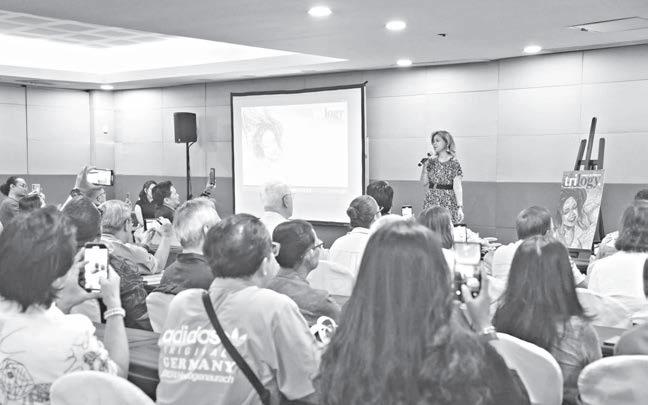
They capture various times in pop culture and general history that also reflect the music of those periods.
And this is why we need more fake books, National Artist for Music Ryan Cayabyab said in his speech during the book launch. We need more books that will not only document OPM (Original Pilipino Music) but will promote it for the rest of the world to play and sing.
Music preservation, promotion “IT is very important for us to not just preserve but to promote our music. Many people tell me, ‘our songs are not getting promoted.’ How can we promote when we don’t have the sheet music? In our circle of professional musicians, we thrive on the extant material, something we can read. Because those materials will be read not just here in the Philippines but in other places as well,” he said.
“If we want to promote our music, we have to have the standard: music, lyrics, and chords. Trina’s book, this is a standard. What will follow is that there will be people who will get in -
onboarding.
n Sun Life Asks —An AIpowered internal chatbot streamlining workplace efficiency, from summarizing text to assisting in presentations.
n Sun Life Mobile App —A seamless platform enabling Sun Life clients to manage accounts, find advisors, and access essential financial resources.
The next segment of the workshop shifted gears to career growth, as Katrina Rodriguez, SLGS Philippines Human Resources and Communications Head, guided attendees through career roadmaps, interview strategies, and workplace tips. Participants also met the newest batch of Sun Risers, fresh hires under SLGS’ onboarding program that ensures a seamless transition into the corpo -
terested to make a vocal-piano score for those who play the piano. Joe Mari Chan has this. So I’m very happy that we are taking our first steps,” he added.
Cayabyab, lovingly called “Mr. C” in the music circle, was Trina’s inspiration for writing Trilogy. He encouraged other songwriters to start working on their own fake books, so that more people will get to know OPM.
“My biggest dream is to have a whole anthology of Filipino music that’s available anywhere. There are a lot of musicians saying, ‘what if our songs get pirated?’ There are systems in place to address that. The bigger point is that we need to have more people performing our songs.
The more we put our pieces out there, the more people will sing our songs,” he said.
Putting the brand out there IN public relations, it is important to get your messages across to your target audiences. What Trilogy can potentially achieve for OPM is two-pronged: make sheet music available to a wider audience so these can be performed and not just heard; and
rate world.
Diversity, Equity, Inclusion, and Belonging (DEI&B) remain at the heart of SLGS’ culture. Through initiatives like Bright Women and other employeeled inclusion networks, SLGS fosters mentorship and career development opportunities tailored for women in technology.
To build a workplace where an inclusive culture supports for women’s empowerment, SLGS celebrated International Women’s Day (IWD) with the theme “Her Health, Her Power” which included activities different initiatives such as participating in the Filipina CEO Circle Women’s Run PH, an HPV Vaccination Drive, Mental Health Webinars, a fun Zumba and Pilates session for women and a Fireside Chat with SLGS
tell the stories behind some of the most listened-to and well loved songs from the past three decades.
If more songwriters came out with their own “fake books,” more people within and outside the country will be able to access and perform OPM songs. These songs will give more people a peek into what the country has to offer in terms of culture, and hopefully make them curious enough about the country to want to get to know it and visit it. A systematic and systemic approach to promoting our culture can bring in huge rewards for the country if done right, using the South Korea hallyu model as a basis. But that takes years to build, driven by a lot of cooperation and collaboration among government and private sector players. It is good to know that there are efforts among stakeholders to lay the required foundations, one stone—or book—at a time.
PR Matters is a roundtable column by members of the local chapter of the United Kingdom-based International Public Relations Association (Ipra), the world’s premier organization for PR professionals around the world. Abigail L. Ho-Torres is the Chief Marketing Officer of Ikigai Philippines and an independent consultant and trainer, with more than two decades of experience in media, public relations, marketing, and customer experience.
We are devoting a special column each month to answer our readers’ questions about public relations. Please send your questions or comments to askipraphil@ gmail.com.
Women leaders as the culminating event. This International Women’s Month, SLGS Philippines celebrates a global movement that paves the way for more women to pursue their goals. At SLGS, we remain committed to breaking down barriers with initiatives like this workshop designed to open new doors for youth, regardless of gender,” said Bernardo.
“ We are excited to continue #AcceleratingAction toward a truly inclusive tech industry by providing insight into the industry and unveiling the exciting career opportunities that await these young women,” she added. For more information on Sun Life Global Solutions Philippines, visit https://www.sunlife. com/slgs/en/.
By Josef T. Ramos


TSaturday night schocker Petro Gazz shocks highly-favored Creamline, 25-23, 2522, 21-25, 25-16, to gain headway while pushing the highly-favored Cool Smashers to the brink of failing to defend their
Antipolo City.

FAR Eastern University (FEU) and University of Santo Tomas (UST) secured two championships each in the inaugural University Athletic Association of the Philippines Season 87 rapid chess tournament that ended Saturday at the Adamson University Gym. FEU topped the boys’ division undefeated while its women’s team overcame two early setbacks in the tournament to stage an impressive comeback and run away with the tiara.
Jerish John Velarde set the tone for FEU’s boys’ championship run by defeating FIDE Master Alekhine Nouri of UST on the top board, pushing Franklin Andes past Jian Carlo Rivera on board 3, with Oscar Cantela and Lemmuel Adena sealing the triumph with tactical draws with John Cyrus Borce and Sumer Oncita on boards 2 and 4, respectively.
CARL DALUZ is in deep concentration in University of Santo Tomas’s campaign.
ACTION returns to Santa Rosa City at the Nuvali Sand Courts By Ayala Land with the Philippine National Volleyball Federation’s (PNVF) hosting of the Rebisco Asian Volleyball Confederation (AVC) Beach Tour Second Nuvali Open from Wednesday (April 2) to Saturday. AVC president Ramon “Tats” Suzara, also head of the PNVF, said that 18 women’s pairs from eight countries and 22 men’s tandems from 11 nations are seeing action in the first of two major international beach volleyball tournaments scheduled this year at Nuvali.
“ The Philippines has become the epicenter of beach volleyball in Asia as proven by this tournament that will gather a total of 40 teams from 11 countries,” said Suzara, who’s also the executive vice president of the world body FIVB, or International Volleyball Federation.
With these top teams coming over, we not only showcase elite beach volleyball but provide our national
teams the opportunity to further sharpen their skills,” added Suzara of the tournament presented by volleyball staunch supporter Rebisco.
The Philippines has four teams in the women’s competitions and three in the men’s contest.
The women’s pairs are Khylem Hari Progella and Sofiah Shanain Pagara, Sunnie Kalani Villapando and Jenny Gaviola, Alexa Polidario and Lorien Isobel Gamboa and Kathrina Epah and Honey Grace Cordero.
Seeing action in the men’s side for the country that will host in September the FIVB Men’s Volleyball World Championship Philippines 2025 are James Buytrago and Rancel Varga, Edwin Tolentino and Lerry John Francisco and Ronniel Rosales and Alexander Jhon Iraya.
The foreign challenge will come from Australia (3 women and 3 men teams), Thailand (3 and 3), China (2 and 2), Japan (3 and 3), Hong Kong (1 and 1), Uzbekistan (1 and 1), Malaysia (1 women) and New Zealand, Iran and Indonesia with two men’s pairs each.

“Maybe luck also played a factor. In the finals, we unexpectedly swept Ateneo, 4-0. That was a very decisive advantage.”
A teneo topped the elimination stage with an undefeated record but failed to replicate its earlier 3.5-0.5 victory over FEU in Round 1. FEU, however, lost to UST in the girls’ and men’s divisions despite emerging top seeds in the single-round robin elimination stage.
Our women’s team’s victory was the most unexpected because they lost twice in the eliminations—they had two losses on the first day,” said FEU assistant coach Woman Grandmaster Janelle Frayna, the league’s Season 77 Athlete of the Year. “Things didn’t look good good at the start of the tournament but after talking with the player and training harder, we won.” Sometimes, young players doubt their capabilities. I think that’s what happened on the first day,” she said.

THE other day, in the midst of Alex Eala’s stirring run at the Women’s Tennis Association’S (WTA) Miami Open, I saw this comment on Facebook, “All of a sudden there are thousands of bandwagon Alex Eala and tennis fans/experts.”
At the same time, with news that Liverpool Football Club’s right back Trent Alexander-Arnold is moving to Real
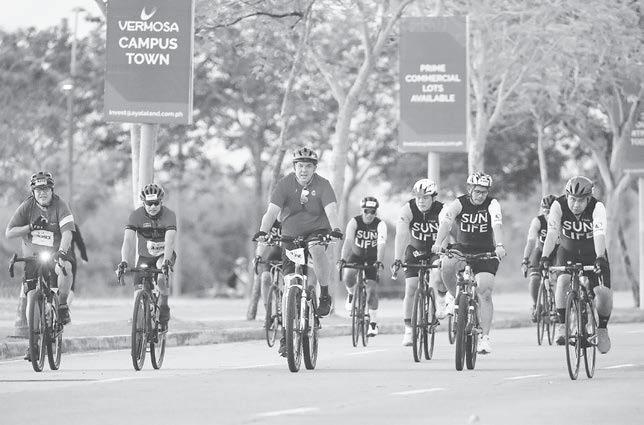
Madrid after this football season, the reaction by many Reds fans was seen as a betrayal. “Traitor!” screamed many.
L ike everything else in life, social media is both good and bad.
First off, I am proud of Eala. The sacrifices made by her family for her tennis career has mightily paid off.
Several years ago, I was writing about this Filipino who was enrolled at the Rafa Nadal Academy. After this Filipina went back to the Philippines to enroll in a college, while going back to the Rafa Nadal Academy, Eala had taken over her slot.
So I began following her and was pleased to see her climb the rankings in women’s single competition.
W hile previously working for TapGo TV (now BlastTV), the streaming site would push the matches of Alex Eala to the general public. There was interest, but not much. Hopefully now, more people will subscribe and watch not only Eala, but the great tennis matches served in this streaming site.
W hen Alex first made waves during the 2020 French Open girls’ competition, we saw her name trend with a new host of fans coming on board. But it waxed and waned until this Miami Open that drew incredible views, shares, hits, likes, and ratings that stole some of the infamous spotlight


on that person on trial at The Hague.
A s for Alexander-Arnold, I get why people are upset. After all, he is Liverpool-born and bred and came up from the academy. If you are a big club, is there any other bigger club?
There’s nothing like wanting to go to a different place, try your hand at also helping them win trophies, and see the world. After all, he has served the club well and has been a part of all the eight trophies they have won in the last several years.
Trent will be the third Liverpool player to move to Real Madrid after Steve McManaman and Michael Owen who had different results playing with the Spanish club football giants as well as after.
M acca is celebrated; Owen vilified more so he went on to play for Manchester United. Personally, I want Trent to stay, but if he feels his destiny lies elsewhere, all I can do is thank him for his service and wish him the best. he isn’t like Mason Amos who ditched Ateneo for La Salle in a sudden and even more shocking manner. That’s Michael Owen territory when you play for your biggest rival.
I don’t get the hate for him.
B ack to Eala, I get the gatekeeper vibe of the older fans as opposed to the hipsters and bandwagoners. It’s that feeling, “yeah

By Anne Ruth Dela Cruz
HONOR, a global leading
AI device ecosystem company, made a big comeback to the Philippine market back in 2022. With its local partner, HONOR Philippines launched in the country as a technology brand that caters to different needs of Filipino technology consumers.
Since its return to the Philippine market, HONOR Philippines has rapidly carved out a strong presence in the market with the opening of physical stores and the successive launch of mobile phone models that suit all needs.
At the helm of its growth is Stephen Cheng, Vice President of HONOR Philippines.
With over a decade of experience in telecommunications and consumer electronics, Cheng has played a pivotal role in shaping marketing strategies, driving business growth and connected brands with consumers.
Communications is key Cheng began his career in media relations at EON Inc., a public relations agency with a focus on storytelling and building trust, where he managed campaigns and client interactions.
“I had three different positions in a span of less than two years. I managed campaigns, media relations, and client interactions. This role helped me understand the importance of communication, relationshipbuilding, and strategic planning in marketing,” Cheng related in an email interview with BusinessMirror.
Prior to joining HONOR Philippines, Cheng served as Vice President for Marketing at XTREME Appliances. He also held leadership roles in OPPO and Vismay International Corp. where he spearheaded brand marketing campaigns, managed budgets and drove market growth through innovative strategies.

With his impressive background, it was only a matter of time before Cheng received an opportunity to work at HONOR Philippines. When asked about his first impression of HONOR, Cheng recalled being immediately drawn to the brand’s commitment to innovation and its deep understanding of consumer needs.
HONOR’s ability to deliver premium, stylish, and accessible technology has positioned it as a rising star in the smartphone industry,” he says.
The challenge for Cheng was how to position HONOR in an highly competitive mobile phone market. For Cheng, differentiation is key.
We position HONOR has a brand that provides premium innovation at an accessible price point. Our focus on engaging digital platforms such as TikTok Shop, and our dedication to understanding and serving the tech-savvy, younger demographic have set us apart,” he said. Agile approach
Having worked for another smartphone brand before joining HONOR, Cheng noted the difference between the two brands.
“HONOR stands out for its agile approach to technology and marketing. It places a strong emphasis on affordability without compromising quality, which resonates deeply with today’s consumers,” Cheng said.
Since its launch in the Philippines, HONOR has seen an impressive growth in sales. Stephen expresses his pride in the brand’s progress, attributing its success to consumer trust and the hard work of the HONOR team.
The HONOR X9a, X9b, and now X9c have been the bestselling products in their price segment for over two years,” he shares.
For Cheng, speed and decisiveness—backed by data and experience—are crucial in marketing a brand successfully. He highlights the importance of understanding the audience and leveraging the right platforms to engage with them. TikTok Shop has been a game-changer for HONOR in reaching its target market, along with strong collaborations with influencers and consistently delivering on brand promises.
“Success comes from understanding your audience and finding the right platforms to engage with them. Additionally, building strong relationships with influencers and delivering on our brand promise have played key roles in our success,” he said.
Reflecting on the industry’s transformation, Cheng noted how it has evolved from simply offering communication devices to creating comprehensive digital ecosystems.
Today, telecoms brands focus on seamless connectivity, AI integration, and enhanced user experiences across multiple devices,” he said.
What’s Next for HONOR? Looking ahead, HONOR is set to expand and innovate its product offerings.
We already have an impressive range of laptops, tablets, and smartwatches,” Cheng revealed.
“Our focus is on upgrading and innovating these product lines to meet the ever-evolving needs of our consumers. We aim to further enhance the seamless connectivity and smart ecosystem that HONOR provides.”
With a clear vision and an unwavering commitment to innovation, HONOR Philippines continues to redefine the industry landscape—one breakthrough at a time.

